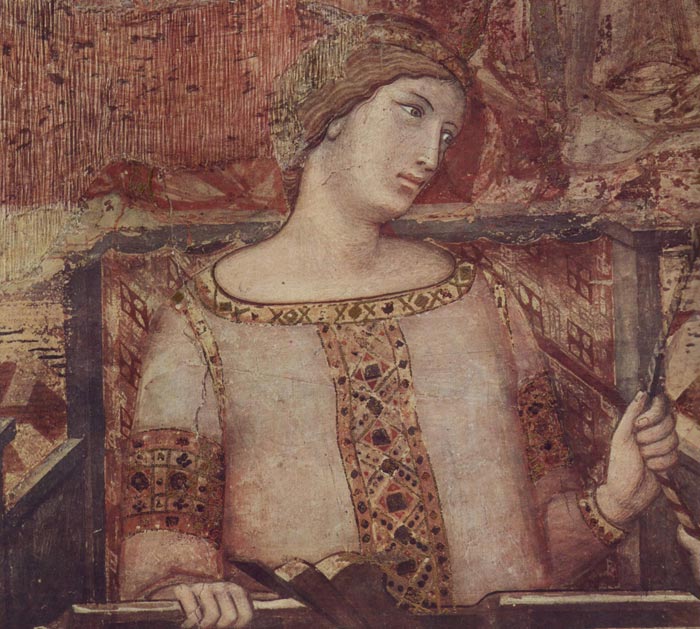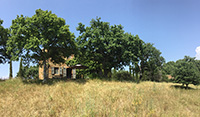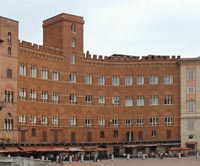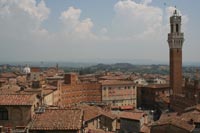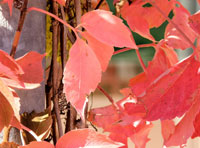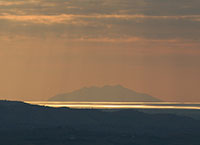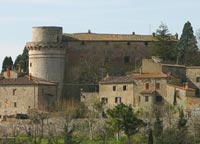| |
|
In the thirteenth and early fourteenth centuries, a greater emphasis on human experience and perceptions prompted artists of many kinds to begin "speaking in the vernacular." Poets in Sicily invented and perfected the sonnet, and Dante wrote the Divine Comedy — not in Latin but Italian. Also for the first time, sermons were given in native Italian dialects by members of influential new religious orders, particularly the Franciscans and Dominicans, who left the shelter of monasteries to preach in cities and towns. Religion focused increasingly on human and humane concerns. The simple virtues of the early Franciscans — who renounced worldly possessions and identified strongly with Christ and his suffering — helped to shift emphasis onto Christ's human nature and to demand of religious art a new and closer identification with people's experience. Artists responded by enhancing the sense of particular time and place with detailed settings familiar to their viewers, by expanding the range of gesture and emotion, and by embroidering their narratives with anecdotal details.
Early Italian artists adopted the techniques and traditions of Byzantine art: the gold backgrounds and timeless figures that give spiritual force to icons. But increasingly they began to convey a physical as well as a spiritual reality. The Renaissance celebration of freedom of self-determination had a profound effect on the visual arts. Whereas medieval art focused on otherworldly truths, Renaissance art was nurtured on the principles of humanism, which also paid tribute to visible reality. Greek and Latin learning emboldened thinkers to place the human being at the center of their world view. Interest in the classical past did not impede Christian devotion; religious art remained dominant, and secular art forms emerged also.
Tuscany was the cradle for the new humanist concerns. While Duccio's fourteenth-century Maestà altarpice for Siena Cathedral owes much of its linear and decorative style to his Byzantine predecessors, certain elements in it derive from the painter's direct observation of nature. As religious emphasis shifted to Christ's human experience, closer identification with people's experience was required of art. Artists responded with details familiar in the lives of their viewers.
The decline of Sienese painting from the second half of the 14th century is so splendidly described by Bernhard Berenson in his essay The Central Italian Painters (first published in 1897):
'Con la morte dei Lorenzetti, Ia scuola Senese entrò in una decadenza da cui non riuscì più a sollevarsi. Ebbe ancora momenti che lasciavano sperare, ore di consunta bellezza, ma non più quel rifluire d'energie senza di che l'arte è condannata all'esaurimento. Il Barna, Bartolo di Fredi, Taddeo dì Bartolo a volte rintracciano un raggio dello splendore martiniano o lorenzettiano. E Domenico di Bartolo tenta alla bell'e meglio di suscitare nuova vita, introducendo forme ed atteggiamenti che i grandi fiorentini avevano allora salvati dal caos e definitivamente fissati. Ma egli non sentiva il vero significato di coteste forme ed atteggiamenti, connessi ai valori tattili e di movimento; e i colleghi e concittadini ebbero buon gusto a preferire, alla sua rettorica eroica e al falso naturalismo, i modi irreali ma amabili d'una tradizione antica e venerata. Sempre attraente, il Sassetta visse e operò come se Firenze fosse lontana non quaranta miglia, ma quaranta milioni di miglia; e come se Masaccio e Donatello, Paolo Uccello e il Castagno non fossero ancora usciti dal limbo dei non nati. E ci letificò con molteplici opere di ricca bellezza decorativa, e con quella scena di splendore visionario ch'è 'Lo Sposalizio del Serafico Francesco', al museo di Chantilly.
Ma sordamente, misteriosamente, le nuove immagini visive e il nuovo senso della bellezza, si fecero strada e penetrarono anche in Siena, malgrado quelle mura accigliate. E il vecchio gusto per la linea, per il lusso delle superfici e gli effetti rudimentalmente decorativi, si combinò ai nuovi ideali. Alla nuova maniera, dipinsero il Vecchietta, Francesco di Giorgio e Benvenuto di Giovanni; e a loro superiori: Matteo di Giovanni e Neroccio de' Landi, i due principali maestri del Rinascimento senese. Matteo aveva un senso del movimento che l'avrebbe portato alla vera arte, se in lui fosse stato congiunto alla necessaria dottrina formale; difettandogli questa, Matteo riuscì una specie di Crivelli inferiore, con effetti lineari come duramente incisi in cuoio dorato o in vecchio ottone. Quanto a Neroccio, lo diremmo un Simone redivivo. La musicale linea di Simone, l'insaziabile, raffinatissimo senso della bellezza, quell'incanto e quell'eleganza, si ritrovano non diminuiti nelle tavole di Neroccio; e in esse è anche qualcosa che a molti di noi preme più: ideali ed emozioni più vicini ai nostri, più acute suggestioni di freschezza e di gioia.
S'era ormai tra la fine del quindicesimo e il principio del sedicesimo secolo, né Siena poteva più contentarsi dei pochi pittori locali. Furono chiamati maestri forestieri: Signorelli, Pinturicchio e il Perugino dall'Umbria, Fra Paolino da Firenze, il Sodoma dalla Lombardia; e poiché non c'erano forze paesane a far resistenza, da tutti questi influssi mescolati, nacque un singolare e grazioso eclettismo, salvato dalla pretensiosità ed eccentricità solite in tali movimenti, grazie a quel senso di bellezza e d'eleganza che, anche sull'ultimo, non mancò quasi mai alla pittura Senese.'
[Bernhard Berenson, Central Italian Painters of the Renaissance (1897) | Art in Tuscany | Bernhard Berenson]
|
|
|
|
|
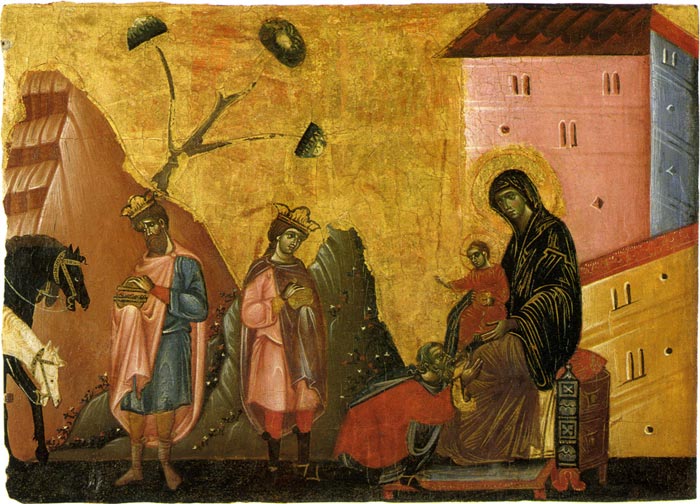 |
Guido da Siena, Adoration of the Magi, about 1275-1280, Altenburg, Lindenau-Museum
|
Duecento | 1251–1300
|
|
|
| I primi dipinti conservati a Siena e nel territorio risalgono al periodo tra la fine del XII secolo e gli inizi del XIII.
La prima opera sicuramente datata (1215) è un dossale in stile romanico-bizantino, con il Redentore benedicente tra i simboli degli evangelisti e storie della Vera Croce: nel riquadro centrale, Cristo è inserito in una mandorla e accompagnato dai simboli dei quattro evangelisti, mentre ai due lati si dispongono due file verticali di tre riquadri più piccoli con le scene figurate[1]. Allo stesso autore anonimo (Maestro di Tressa), è attribuita la Madonna dagli occhi grossi, in origine sull'altare maggiore del duomo (1220-1230)[2].
Alla seconda metà del XIII secolo si riferiscono la Madonna in maestà della chiesa di San Domenico (Maestà di San Domenico), firmata da Guido da Siena, influenzata dalla Madonna del Bordone, del fiorentino Coppo di Marcovaldo, del 1261, della chiesa dei Servi.
Contemporanei di Guido da Siena furono Dietisalvi di Speme e Guido di Graziano: quest'ultimo risente dell'influenza di Cimabue per la ricchezza di tonalità dei colori e la fluidità delle linee; gli sono attribuiti[3] i dipinti con San Pietro in cattedra e con San Francesco della Pinacoteca nazionale di Siena.
Le personalità pittoriche di questo periodo sono soprattutto documentate nelle "biccherne", i dipinti commissionati dalle magistrature cittadine della Biccherna e della Gabella per le tavole di legno che costituivano le copertine dei libri contabili.
Della fine del secolo sono ancora le prime opere di Duccio di Buoninsegna (Madonna di Crevole dall'eremo di Montespecchio, oggi nel Museo dell'Opera metropolitana del Duomo, datata intorno al 1280 e Madonna dei Francescani, nella Pinacoteca nazionale, datata a circa il 1290[4]), nelle quali si avverte il progressivo inserimento di elementi della pittura gotica e di una maggiore spontaneità nei gesti del Bambino. Del 1288 è la vetrata circolare del Duomo, oggi nel Museo dell'Opera metropolitana, della quale Duccio fornì il disegno e sulla quale intervenne poi a pennello.
In scultura si ebbe nel corso dello stesso secolo la realizzazione del pulpito opera di Nicola Pisano (1266-1269), mentre il figlio, Giovanni Pisano venne incaricato della decorazione scultorea della facciata del duomo (1284-1297).
|
Master of Tressa
|
|
|
Maestro di Tressa, attivo tra il 1220 e il 1240/50 c.a.
La tavola con la Madonna e il Bambino, attribuita al ‘Maestro di Tressa’, proveniente dalla chiesa di Santa Maria a Tressa, da cui l’artista ha tratto il nome. |
|
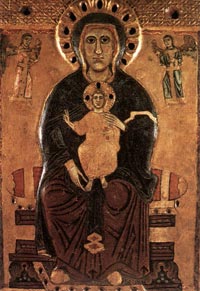
Maestro di Tressa, Madonna dagli occhi grossi, Museo dell'Opera metropolitana del Duomo, Siena
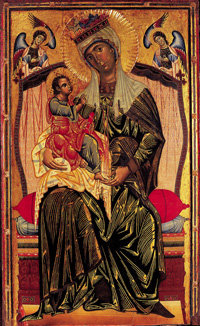
Coppo di Marcovaldo, Madonna col Bambino, 1270 circa, chiesa di Santa Maria dei Servi, Orvieto (opera attribuita anche al figlio di Coppo di Marcovaldo Salerno di Coppo)
|
| |
|
Coppo di Marcovaldo
|
|
Coppo di Marcovaldo (Firenze, ca. 1225 – ca. 1276) è stato un pittore italiano, una delle figure più eminenti della pittura toscana del XIII secolo, il più importante a Firenze prima di Cimabue ed uno dei pochi maestri duecenteschi del quale si conosca il nome.
Originario del Popolo di San Lorenzo a Firenze, nacque attorno al 1225-1230 circa: quando nel 1274 è registrato a Pistoia a lavoro col figlio Salerno doveva infatti avere sui cinquant'anni[1].
La tavola conservata al Museo di San Casciano di San Casciano in Val di Pesa, San Michele Arcangelo e storie della sua leggenda è attribuita dalla critica recente a Coppo e sarebbe la sua opera più antica, eseguita a tempera con argentature a mecca indicativamente tra il 1255 e il 1260[1].
Nel 1260 partecipò alla battaglia di Montaperti, dove venne catturato dai senesi, come risulta da un elenco di prigionieri tenuti in Siena. Per riscattarsi dipinse una grande Maestà, la Madonna del Bordone, che firmò e datò 1261. Questa è l'unica sua opera certa, destinata alla chiesa di Santa Maria dei Servi a Siena dove si trova tuttora[1]. A causa di questa sua presenza a Siena venne in passato equivocato come appartenente alla scuola senese. La tavola venne ritoccata alcuni decenni dopo da un artista senese, ma grazie a radiografie, è stato possibile leggere lo strato sottostante, confermando uno dei tratti salienti della pittura di Coppo, cioè l'uso di pennellate pastose poco sfumate, quasi tratteggiate. Questo modo di dipingere appartiene alla corrente di Giunta Pisano e prevedeva forti contrasti di chiaro scuro tramite la contrapposizione di ombre e lumeggiature con pochissime sfumature. A differenza della concentrata astrazione di opere come quelle di Margaritone d'Arezzo, il Bambino nella Madonna di Coppo guarda teneramente la madre, un gesto che umanizza la divinità, ma che simboleggia anche la trepidazione con la quale Dio (il Bambino) guarda alla Chiesa (l'Ecclesia simboleggiata dalla Madonna). Notevoli sono le lumeggiature dorate dei panneggi, che creano un senso del volume del corpo al di sotto delle vesti.
A Siena stette circa nove anni, dipingendo anche il Crocifisso poi destinato a San Gimignano[1].
Un'opera simile, non univocamente attribuita a Coppo, è la Madonna col Bambino nella chiesa di Santa Maria dei Servi di Orvieto, dove è evidente una maggiore energia in alcuni dettagli, come le striature dorate più evidenti, la curvatura dello schienale della Madonna più ampia, quasi a creare una quinta. Inoltre la posa è leggermente differente con la Madonna di poco più arcuata per il movimento "irrequieto" delle gambe del Bambino.
Nel 1265 risulta attivo a Pistoia dove affrescò la cappella di San Jacopo nel Duomo, opera non più esistente.
Coppo prese parte alla straordinaria decorazione musiva del Battistero di Firenze realizzando alcuni cartoni. A lui è assegnato il visionario Giudizio finale in particolare per la parte che riguarda l'Inferno, databile tra il 1260 e il 1270 circa; la presenza di campiture di colore applicate a striature ricorda in particolar modo lo stile di Coppo. Il mosaico estremamente ricco, dal punto di vista iconografico è indubbiamente innovativo e va senz'altro citato tra i capolavori del XIII secolo. A questa visione si ispirò probabilmente Dante Alighieri per la descrizione di qualche scena dell'Inferno.
Giotto replicò questa parte del mosaico fiorentino nel Giudizio affrescato sulla controfacciata della Cappella degli Scrovegni a Padova.
Nel 1274, con il figlio Salerno, dipinse per la cattedrale pistoiese cinque tavole, di cui restano la Croce tuttora in loco. Le altre opere erano una Madonna, un San Giovanni, un San Michele e un secondo Crocifisso.
Nella difficoltà di formulate attribuzioni certe alla pittura duecentesca, così legata a modelli fissi, molti lavori sono stati attribuiti a Coppo, uno dei pochi nomi legati a un catalogo di opere. Oggi si tende a sfrondare tali attribuzioni incerte o con scarso seguito, approcciandosi alla materia con più cautela.
|
|
| |
|
|
Guido of Siena
|
|
|
Guido da Siena (circa 1230 – circa 1290) è stato un pittore italiano, attivo a Siena nella seconda metà del Duecento, fra il 1260 e il 1280.
Non ci sono notizie sulla vita dell'artista, nessun documento lo nomina (a meno che non lo si voglia identificare col Guido di Graziano documentato a Siena nell'ultimo ventennio del Duecento). La sua carriera artistica è quindi ricostruibile solo tramite i dipinti che realizzò. Fu probabilmente influenzato dall'arte di Coppo di Marcovaldo e si distinse a Siena (forse la sua città natale) tra gli altri pittori a lui coevi, dalle cui botteghe uscì certamente Duccio di Boninsegna.
La Maestà in San Domenico
La sua Maestà, conservata ancora oggi nella Basilica Cateriniana di San Domenico a Siena[1], rappresenta la Madonna assisa in trono con il Figlio in braccio, assistita da sei angeli; nella cuspide il Redentore Benedicente circondato da due angeli. L'opera, che misura 283x194 cm, è datata tra il 1265 e il 1270. La scritta posta nel dipinto:
"ME GUIDO DE SENIS / DIEBUS DEPINXIT AMENIS / QUEM CHRISTUS LENIS / NULLIS VELIT ANGERE PENIS - A.D. MCCXXI"
(Mi dipinse, in giorni felici, Guido da Siena che Cristo benigno non voglia angustiare con alcuna pena. a.D. 1221)
è quindi da considerare una manipolazione posteriore all'esecuzione della Maestà [2]. Questo è suffragato anche dallo stile dei volti, decisamente risalenti ad un periodo posteriore, forse la prima metà del Trecento. Tale "modifica" fu probabilmente dovuta a Duccio di Boninsegna o a un suo seguace.
La Maestà di Guido è la prima grande immagine della pittura senese che si conosca ed è la premessa alle successive Maestà di Duccio e di Simone Martini.
La tavola di Badia Ardenga
Nel Settecento era documentata nella Badia Ardenga una tavola antica con storie di Cristo, poi smembrata e parzialmente dispersa. Si ritiene di poterla identificare con le sei Storie dell'infanzia di Cristo e sei Storie della Passione di Cristo, databili al 1275-1280 circa, oggi in musei diversi.
Si è a lungo creduto che questi dodici episodi (forse con altri dodici perduti) costituissero i due sportelli laterali della Maestà di San Domenico, ma studi recenti hanno escluso questa ipotesi. Resta indubbia l'attribuzione a Guido da Siena di tutte le tavolette, seppure non si esclude l'intervento della bottega.
Dalla stessa chiesa (e dunque forse dallo stesso insieme smembrato) proviene anche un'altra tavola attribuita a Guido, Incoronazione della Vergine, Courtauld Gallery.
|
|
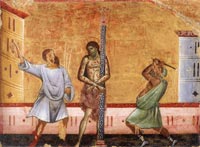
Guido da Siena, Flagellazione, 1275-1280 ca., Altenburg, Lindenau-Museum
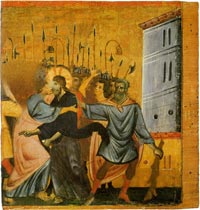
Guido da Siena,
Tradimento di Cristo, 1275-1280 ca., Pinacoteca Nazionale di Siena |
|
|
Rinaldo da Siena
|
|
|
Rinaldo da Siena è stato un pittore e miniatore italiano, attivo a Siena tra il 1260 e il 1281 circa. È identificato oggi con il Maestro delle Clarisse.
Le scarse notizie biografiche riguardano essenzialmente una tavoletta di biccherna documentata nel luglio/dicembre 1278 (pagata a un certo "Rinaldo"), sulla base della quale Luciano Bellosi, nel 1991, ricostruì una personalità pre-duccesca, basandosi su un'intuizione di Boskovits (1985) e identificandolo con quello che Garrison (1949) e Stubblebine (1964) avevano indicato come "Maestro delle Clarisse", legato cioè alla tavola con Cristo e la Vergine in trono dal convento delle Clarisse a Siena. |
|

Rinaldo da Siena, Crocifisso
|
|
|
|
Master of Badia a Isola
|
|
|
Maestro di Badia a Isola (fl. c. 1290-1320 – ...), già identificato da alcuni studiosi con lo stesso Duccio di Buoninsegna in una fase giovanile, potrebbe essere stato un emulo (piuttosto che un precoce seguace) di Duccio, da cui ha ripreso la solidità plastica e certi preziosismi, quest'ultimi da riferire al gusto bizantineggiante propria dei pittori senesi più arcaici.
La studiosa Coor-Achenbach nel 1955, individuando qualche richiamo nella pittura di Ugolino di Nerio, aveva anche proposto la sua identificazione con il padre di Ugolino, il pittore Nerio.
La Maestà eponima
L'anonimo pittore deve il suo nome alla Maestà un tempo conservata proprio nella chiesa di San Salvatore a Abbadia a Isola, presso Monteriggioni, ed oggi ospitata nel Museo civico e d'arte sacra di Colle di Val d'Elsa.
Il dipinto raffigura una Madonna col Bambino in trono e due angeli. La Madonna, avvolta in un manto scuro e lumeggiato a oro, sostiene dolcemente il Bambino che accenna un gesto benedicente; è assisa su un trono marmoreo frontale ma con un accenno di prospettiva, ai lati del quale sono raffigurati due angeli. Alcune caratteristiche di stile rimandano ancora a certe soluzioni cimabuesche (come il naso a forcella dei volti), ma la composizione generale e l'impianto architettonico del trono indicano la conoscenza delle innovazioni della pittura di Giotto.
L'abbazia dei Santi Salvatore e Cirino) si trova ad Abbadia a Isola nel comune di Monteriggioni.
Per l'organizzazione spaziale e per le scelte decorative la chiesa abbaziale è stata il modello a cui hanno attinto in seguito per realizzare le pievi di Scola, di Ponte allo Spino, di Pernina e di Casole e in quanto modello per la pieve casolana, completata nel 1161, è un edificio databile alla metà del XII secolo ma non oltre il 1173. |
|
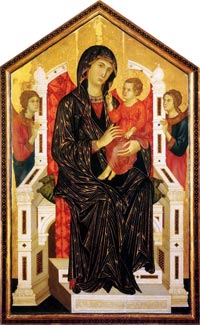
Master of Badia a Isola, Madonna col Bambino in trono e due angeli , Museo civico e d'arte sacra Colle di Val d'Elsa |
|
|
|
|
|
|
Duccio di Buoninsegna nacque a Siena nel 1255 circa. Fu uno dei più importanti esponenti della pittura senese della metà del 200.
Alla sua produzione giovanile appartiene la Madonna di Crevole che si trova al museo dell'opera del Duomo di Siena. In quest'opera sono evidenti i modelli della sua formazione: il panneggio schematico e l'uso dell'oro provenienti dalla pittura bizantina, elementi derivanti dalla miniatura gotica e motivi iconografici tipicamente bizantini. Nello stesso periodo mentre Cimabue e i suoi seguaci cercano di rappresentare lo spazio tridimensionalmente e volumetricamente, Duccio cerca di focalizzare la sua attenzione sull'eleganza delle forme e delle linee e sull'armonia dei colori. Per esempio questo è evidente nella Madonna Rucellai eseguita nel 1285 per la chiesa di Santa Maria Novella a Firenze e che oggi si trova alla Galleria degli Uffizi. Un tempo questo dipinto era attribuito a Cimabue ma poi alcuni elementi hanno proposto l'attribuzione a Duccio, peresempio i motivi tipici della cultura bizantina e il fatto che manca in quest'opera il senso volumetrico tipico della pittura del Cimabue.
Nel 1308 e gli venne commissionata la pala della Maestà per il Duomo di Siena che oggi si trova al Museo dell'opera del Duomo. Il dipinto, terminato nel 1311, rappresenta sul recto la Madonna in trono tra angeli mentre nella parte posteriore, divisa in 26 scomparti, vi sono rappresentati episodi della passione di Cristo. In origine nella parte sottostante della pala era presente una predella con una storie dell'infanzia di Cristo. Influssi del gotico francese appaiono evidenti nelle linee dei contorni estremamente morbide e nella scelta dei colori, lafigura centrale della Madonna col bambino non ha una vera e propria consistenzavolumetrica e risulta sproporzionata rispetto alle figure che la circondano. Un'altra opera di Duccio di Buoninsegna è la Madonna dei Francescani che si trova alla Pinacoteca Nazionale di Siena, per alcuni quest'opera è ritenuta prodotto giovanile per altri è da considerarsi più tarda. La piccola pala ha uno sfondo quadrettato tipico delle miniature gotiche francesi.
Tra le opere tarde del pittore che corrispondono pienamente al suo gusto pittorico, con spunti tratti dalla miniatura gotica francese, con una delicata stesura dei colori, con le rispondenze ritmiche e lineari, un'iconografia tipicamente bizantina, ricordiamo il Trittico della Madonna e il Polittico di Siena.
Duccio di Buoninsegna morì nel 1318 circa.
Arte in Toscana | Duccio di Buoninsegna
|
|
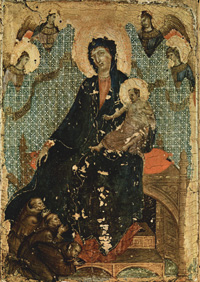 Duccio, La Madonna dei Francescani, ca 1280, Pinacoteca Nazionale, Siena Duccio, La Madonna dei Francescani, ca 1280, Pinacoteca Nazionale, Siena
|
|
|
|
Segna di Bonaventura è stato attivo dal 1298 a 1331 circa. Nel 1306 dipinse una tavoletta per la Magistratura della Biccherna nel Palazzo Pubblico di Siena. Nel 1317 realizzò un pannello per l'altare del convento agostiniano di Lecceto. Due anni dopo dipinse la figura della Vergine Maria nel Pubblico Palazzo a Siena. Sempre per il Palazzo Pubblico nel 1321 dipinse un'altra tavola. I suoi figli Niccolò di Segna e Francesco di Segna di Bonaventura furono validi pittori nell'ambito della scuola senese. Come Duccio, i dipinti di Segna di Bonaventura sono caratterizzati da ritmi graziosi e curvilinei e sottili miscele di colori.
Come Duccio, i dipinti di Segna di Bonaventura sono caratterizzati da ritmi graziosi e curvilinei e sottili miscele di colori. La Alte Pinakothek di Monaco di Baviera, l'Honolulu Academy of Arts e il North Carolina Museum of Art sono tra le collezioni pubbliche aventi dipinti di Segna di Bonaventura. A Massa Marittima si conserva un suo Crocifisso dipinto e nella Sala del Capitolo, detta Definitorio, dell'Abbazia di Monte Oliveto Maggiore una tavola con la Madonna col Bambino.
|
|
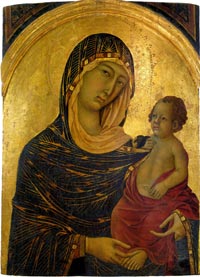
Segna di Bonaventura, Madonna col Bambino, 1325-1330 |
|
|
|
Niccolo di Segna
|
|
|
Niccolò di Segna (notizie dal 1331 al 1345), allievo del padre Segna di Buonaventura, fu sensibile ai modi di Duccio e di Simone Martini. Collaborò con Pietro Lorenzetti agli affreschi della basilica dei Servi e dipinse alcune Storie di santa Fina nella collegiata di San Gimignano.
La cattedrale di Sansepolcro ospita pregevoli opere.
Sull'altar maggiore della cattedrale di Sansepolcro è collocato il polittico della Resurrezione, opera senese del XIV secolo realizzata da Niccolò di Segna attorno al 1348.
Resurrezione nel Duomo di Sansepolcro
La Resurrezione e Sansepolcro sono strettamente legati. Intanto la città fu fondata da due santi pellegrini di ritorno dalla Terrasanta con reliquie del Santo Sepolcro. E poi il quadro forse più famoso di Piero della Francesca è una Resurrezione conservata nel Museo di Sansepolcro. Il quadro ha molti punti di contatto con questo Polittico della Resurrezione di Niccolò di Segna dipinto un secolo prima.
Art in Tuscany | Niccolò di Segna
|
|
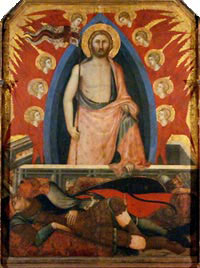
Resurrection by Niccolò di Segna |
Ugolino di Nero
|
|
|
Ugolino di Nero, also known as Ugolino da Siena, was probably a pupil of Duccio and perhaps his most faithful follower. He is documented in Siena from 1317 to 1327 and appears to have been an important artist with a successful workshop. None of the documents mentions works of art, however, and it has proved difficult to reconstruct his career. His principal surviving documented work, a polyptych from Santa Croce, Florence, dating from 1325-30, is now dispersed.
Ugolino was influenced not just by Giotto, but by other Sienese artists following in Duccio's footsteps, such as Simone Martini and Pietro Lorenzetti. Both of these were linked to the papal court at Avignon, where the Italian style mixed with French Gothic.
The early Italian High Altar by Ugolino di Nerio for Santa Croce, the great Franciscan church of Florence, is well-documented. With at least thirty-five sections in all, this massive altar was painted and erected c. 1325-30. These panels recall Duccio's sense of style and organization, as Ugolino was still working with Byzantine line and colour. The altar was dismantled shortly after 1566 and moved to the church's dormitory. By the 1830s, most of its panel had been sold. Now the surviving panels are scattered among museums and private collections.
Art in Tuscany | Ugolino di Nerio
|
|
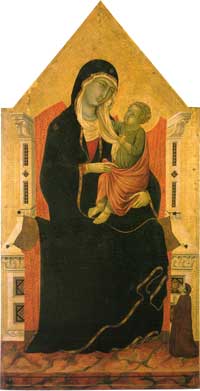 Ugolino di Nerio, Madonna col Bambino tra i santi Pietro e Romolo, Certaldo, Museo di arte sacra |
|
|
|
Maestro di Monte Oliveto
|
|
|
Art in Tuscany | Master of Monte Oliveto |
|
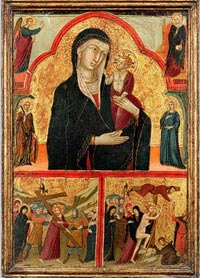
Master of Monte Oliveto, Tabernacle Center with the Madonna and Child, Annunciation, Via Crucis, and Christ Mounting the Cross, ca. 1325, Alana Collection, Delaware |
| |
|
|
|
|
|
Simone Martini è considerato indiscutibilmente uno dei maestri della scuola senese e sicuramente uno dei maggiori e più influenti artisti del Trecento italiano, l'unico in grado di contendere lo scettro a Giotto. La sua formazione avvenne, probabilmente, nella bottega di Duccio di Buoninsegna.
Simone Martini nasce a Siena nel 1284, della sua formazione artistica si sa poco. In molti critici suppongono che egli fosse allievo del pittore Duccio di Buoninsegna. La sua opera degli esordi risente, infatti, degli stilemi artistici dell'artista. A soli quattro anni dalla collocazione della Maestà del Duccio sull'altare maggiore del Duomo di Siena, Martini dipinge un'altra Maestà. E' il 1315 e l'affresco viene collocato nel Palazzo pubblico di Siena. Martini è ancora molto giovane, ma sicuramente è già un pittore qualificato, tanto da aver ottenuto un incarico di una certa importanza. Nel 1321, l'affresco verrà ritoccato dallo stesso autore, per motivi di restauro ma anche per ammodernare alcune caratteristiche che egli, evidentemente, trova desuete. Un documento del 1317 attesta il pagamento in favore di un Simone cavaliere da parte di Roberto d'Angiò. E' quasi certo che egli fosse il Martini, che firma una tavola rappresentante San Ludovico di Tolosa (fratello di Roberto) che incorona il d'Angiò. In quegli anni il pittore attende alla complessa decorazione (comprendente affreschi e vetrate) della cappella di San Martino, nella Basilica Inferiore di San Francesco ad Assisi. Considerata la più alta espressione dei valori cortesi e cavallereschi, la cappella rappresenta un perfetto connubio tra valori religiosi e laicità, aprendo la via ad un'arte che pone l'attenzione sul terreno e sull'uomo.
La Basilica di San Francesco
Il complesso basilicale si compone di due chiese sovrapposte, l'Inferiore (1228-1230) e la Superiore (1230-1253), oltre ad una cripta, scavata nel 1818, con la tomba del Santo, dove riposano le spoglie in un semplice sarcofago poggiato sulla viva roccia. Si accede alla prima dalla piazza inferiore, delimitata da un portico del '400. Il bel portale gemino è sormontato da tre rosoni.
I più grandi maestri del '200 e '300 quali Cimabue, Giotto, i Lorenzetti e Simone Martini hanno affrescato le pareti e i soffitti della Basilica.
Nella Chiesa Inferiore nacque la grande pittura italiana: la navata conserva affreschi del Maestro di S.Francesco; la cappella di S.Martino presenta il ciclo completo delle storie del santo dipinto da Simone Martini; la cappella della Maddalena fu affrescata da Giotto; un affresco di Cimabue è ammirabile sul transetto destro; sul transetto sinistro Pietro Lorenzetti ha dipinto alcune storie della Passione di Cristo. La crociera sopra l'altare, dipinta dal Maestro delle Vele, rappresenta la gloria di S.Francesco e le allegorie della Obbedienza, della Castità e della Povertà.
Arte in Toscana | Simone Martini
|
|
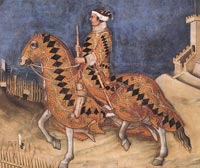
Simone Martini, Guidoriccio da Fogliano all'assedio di Montemassi, affresco, Sala del Consiglio, Palazzo Pubblico di Siena
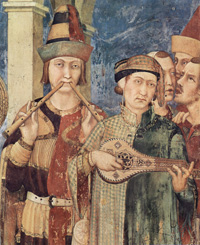 Investitura di San Martino (dettaglio dei musici), Cappella di San Martino, Basilica inferiore di san Francesco d'Assisi Investitura di San Martino (dettaglio dei musici), Cappella di San Martino, Basilica inferiore di san Francesco d'Assisi
|
Simone Martini nel 1333 dipinse per la cattedrale senese, insieme al cognato Lippo Memmi, autore dei due Santi laterali, l’Annunciazione fra Sant’Ansano e Santa Massima, uno dei capolavori dell’arte gotica, conservata oggi agli Uffizi, mancante, purtroppo, del tondo centrale in alto, con la raffigurazione del Padreterno, andato perduto.
Imprimendo un’impostazione ritmica al dipinto, basato su linee di contorno sinuose, in penetrazione psicologica dei personaggi, con la squisita eleganza esecutiva che gli era propria, Simone Martini immortalò, in un bagliore di oro, contro il fondo divino, figure quasi irreali, la Vergine, timida e schiva, raffigurata nell’atto di ritrarsi turbata (la conturbatio, il momento di turbamento, addirittura spavento) con un gesto scontroso delle spalle e del braccio destro, dinanzi al fulgido arcangelo Gabriele (che nell’iconografia ha il compito di annunciare la nascita di Giovanni Battista e di Gesù), con il mantello, ancora svolazzante, appena giunto al suo cospetto, con indosso una veste di colore dorato, che riflette il suo appellativo di "messaggero della luce", un ramoscello di ulivo fra le mani, simbolo della pace universale che si diffonderà sulla terra dopo la venuta del Salvatore.
La Vergine, dal volto giovane, sottile e aristocratico, è seduta su un ricco trono intagliato con motivi decorativi, sullo schienale del sedile è appoggiato un prezioso drappo ornato con motivi floreali dorati su fondo rosso.[3] |
|
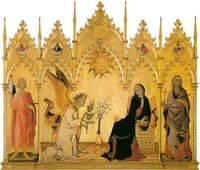
Simone Martini, l’ Annunciazione fra Sant’Ansano e Santa Massima, 1333, Galleria degli Uffizi, Firenze
. |
|
|
|
Lippo Memmi
|
|
|
Nel contesto senese della prima metà del XIV secolo, Lippo Memmi è uno degli autori più significativi e senz'altro la sua arte fu estremamente apprezzata in quanto rispecchiante i gusti più tipici dell'aristocratico ambiente senese dell'epoca. Di tutti gli autori senesi oggi la critica tende forse ad apprezzare di più coloro i quali sono riusciti a distaccarsi da questi stilemi (ad esempio Ambrogio Lorenzetti) e che nella prima metà del XIV secolo non trova nessun pittore veramente in grado di esprimersi al livello di Simone Martini.
Lippo Memmi (c. 1291 – 1356) si formò nella bottega del padre, Memmo di Filippuccio (notizie dal 1294 al 1317), probabile collaboratore di Giotto ad Assisi e pittore civico a San Gimignano.
Ai lavori su tavola realizzati a San Gimignano si aggiunsero una serie di opere commissionatagli il 21 aprile del 1466 dai priori del Comune per il Palazzo Comunale delle quali sopravvive un affresco con Cristo in croce adorato dai santi Girolamo e Francesco e il committente (probabilmente il podestà di San Gimignano), staccato e conservato presso il Museo d’Arte Sacra, e un secondo lavoro del tutto particolare nel suo genere: il restauro della Maestà eseguita da Lippo Memmi nel 1317 nella Sala del Consiglio, oggi denominata Sala di Dante. Questo affresco era considerato uno dei simboli della gloria civica locale ed aveva già subito delle trasformazioni da parte di un pittore senese nella seconda metà del Trecento che aveva esteso la scena con l’aggiunta di due coppie di santi.
Art in Tuscany | Lippo Memmi
|
|
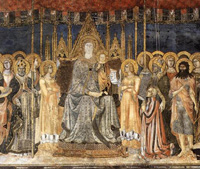
Lippo Memmi, Maestà, Palazzo Pubblico,
San Gimignano |
|
|
|
|
|
|
Naddo Ceccarelli
|
|
|
Naddo Ceccarelli è stato un pittore senese, allievo di Simone Martini, attivo tra il 1325 e il 1350.
La sua personalità artistica è stata ricostruita grazie a due opere firmate: il Cristo morto del Liechtenstein Museum di Vienna e e la Madonna col Bambino nella collezione Cook di Richmond. Influenzato fortemente da Simone Martini e Lippo Memmi, appartenne alla scuola senese.
|
|
|
Lippo Vanni
|
|
|
Lippo Vanni, come suo fratello Andrea Vanni non era solo un artista, ma anche un politico che ricoprì diverse posizioni nel governo di Siena, e fece parte del Consiglio dei Dodici.
Fu uno del più dotati, nel campo della pittura, fra i senesi minori del sec. XIV; trasse ispirazione da Simone Martini, e successivamente subì l'influenza anche dei Lorenzetti, soprattutto di Pietro, del quale è da considerare forse il seguace più completo e maturo.
Il Vanni lavorò moltissimo in Siena e nei dintorni e fu attivo anche a Rosia. Tra le opere sicure, ricordiamo: le miniature per lo Spedale della Scala (1345), ora al Museo dell'Opera del Duomo a Siena; il trittico nella Chiesa dei SS. Domenico e Sisto a Roma (1358); gli affreschi nel Chiostro di S. Domenico a Siena (1372); il grande affresco a monocromo della « Battaglia della Val di Chiana» (1372), nella Sala del Mappamondo del Palazzo Pubblico di Siena, nel quale è ricordata la vittoria dell'esercito senese, comandato dal Conte Giordano Orsini, sulla Compagnia inglese del Cappello, comandata dal Conte Nicolò da Montefeltro, nella battaglia svoltasi appunto in Val di Chiana nel 1363.
Il Vanni eseguì inoltre vari affreschi con «Storie della Vergine» nell'Eremo di S. Leonardo al Lago, presso Siena, fra cui citiamo «La Presentazione di Maria al Tempio» e «Lo Sposalizio di Maria»; in quest'opera, l'arte del Vanni raggiunge i suoi esiti più alti e significativi.
Art in Tuscany | Lippo Vanni
Art in Tuscany | Sienese Biccherna Covers | Biccherne Senesi |
|
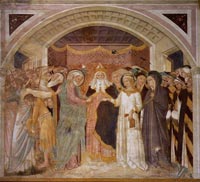 The Betrothal of the Virgin
The Betrothal of the Virgin, 1360s, fresco, San Leonardo al Lago, Siena |
|
|
|
Ambrogio Lorenzetti
|
|
|
Ambrogio Lorenzetti nasce a Siena, probabilmente poco prima del 1300. Con lui e con suo fratello Pietro si conclude la grande stagione artistica senese del XIV secolo. Le notizie sulla sua vita sono poche e imprecise. Sembra certo che egli fosse il minore dei due e che entrambi appartenessero alla bottega di Duccio di Buoninsegna. Sebbene influenzato dalla pittura senese, Ambrogio, però, si accosta agli stilemi giotteschi.
Oggi, l'identità artistica dei due fratelli è molto chiara e la critica tratta con distinzione due personalità che, dal punto di vista pittorico, hanno ben pochi tratti in comune. Altrettanta chiarezza non si può riscontrare nelle nozioni che i contemporanei e gli storici rinascimentali ebbero sui due fratelli, se è vero che Vasari ignora la loro parentela e sembra preferirgli il fratello Pietro, mentre il Ghiberti ne loda capacità, umanità e saggezza, definendolo "altrimenti dotto che nessuno degli altri" e ponendolo al di sopra di Simone Martini.
La prima opera accreditata di Ambrogio risale al 1319. Si tratta di una "Madonna con bambino" dipinta per la chiesa di Vico l'Abate, piccola località nei pressi di Firenze. Da questa data in poi si può supporre che Ambrogio, pur provenendo da Siena, lavori in Firenze. La sua presenza in città è forse più che saltuaria, se nel 1327 viene immatricolato nell'Arte dei Medici e degli Speziali, che da quella data include i pittori e della quale fa parte lo stesso Giotto.
Ambrogio, dunque, lavora assiduamente a Firenze e nella sua città natale, spesso in collaborazione col fratello. La sua reputazione di pittore risulta essere ottima e la critica accredita una forte influenza della pittura di entrambi i Lorenzetti sia in patria che fuori. La scuola senese conserva a lungo l'impronta dei due maestri e produce molti loro seguaci. Nel 1347, l'anno prima della morte avvenuta nella terribile peste del '48, Ambrogio viene eletto membro del Consiglio dei Pacieri di Siena, carica che probabilmente gli viene conferita per la sua fama di grande pittore.[4]
Arte in Toscana | Ambrogio Lorenzetti
Arte in Toscana | Ambrogio Lorenzetti | Allegoria ed Effetti del Buono e del Cattivo Governo
|
|
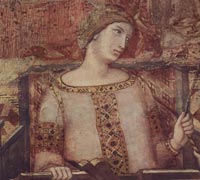 Ambrogio Lorenzetti, Allegory of Good Government (detail), Palazzo Pubblico, Siena, 1338-40 Ambrogio Lorenzetti, Allegory of Good Government (detail), Palazzo Pubblico, Siena, 1338-40
|
|
|
|
Pietro Lorenzetti
|
|
|
Di Pietro Lorenzetti, nato a Siena intorno all'ultimo ventennio del 1200, poco o nulla si sa. Spesso le esili notizie sulla sua vita si confondono con quelle relative al fratello Ambrogio. I due pittori, però, furono artisticamente, e pare anche umanamente, molto diversi. Se il Ghiberti loda Ambrogio, egli ignora del tutto Pietro, mentre Vasari definisce Pietro filosofo e letterato, oltre che artista, gli dedica una delle sue Vite, ma dimostra di non sapere della sua parentela con Ambrogio. Si suppone che Pietro fosse il maggiore dei due e che studiasse di pittura nella bottega di Simone Martini in Siena. Niente altro si sa della sua vita, eccezion fatta per gli spostamenti tra alcune città toscane e umbre, accreditati dalla datazione delle sue opere. Nei primi anni del 1300 fu, sicuramente, ad Assisi. Dopo il '15, si mosse verso Firenze e vi soggiornò per un periodo sufficientemente lungo per dipingere un Polittico e alcune opere singole in luoghi sacri. In questo stesso periodo fu a Cortona, forse solo per il tempo strettamente necessario a dipingere la Croce della chiesa di San Marco. Tra il 1326 e il 1329 Pietro tornò ad Assisi per affrescare il braccio sinistro della Basilica Inferiore di San Francesco. Il ciclo pittorico consta di numerose scene. Di sicura attribuzione sono la Discesa al Limbo, la Risurrezione, la Deposizione. A lungo i critici hanno discusso sulla paternità di altre scene, è certo, comunque, che egli lavorasse con maestranze. Dopo il '29 Pietro tornò nella città natale. A Siena dipinse una celebre Natività, nella quale il suo stile si dimostra maturo e composito. Pare che egli trovasse la morte nel 1348, probabilmente colpito dalla peste, che uccise anche il fratello Ambrogio. [5]
Arte in Toscana | Pietro Lorenzetti
|
|
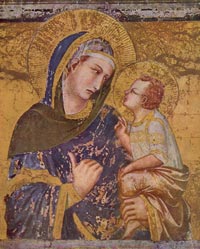 Pietro Lorenzetti, Madonna dei Tramonti, San Francesco, Assisi Pietro Lorenzetti, Madonna dei Tramonti, San Francesco, Assisi
|
|
|
|
Barna da Siena
|
|
|
E stato un pittore senese (attivo intorno alla metà del sec. XIV). Gran parte delle notizie su questo artista ci sono fornite dal Vasari, secondo il quale Barna lavorò a Siena, Cortona, Arezzo, Firenze e San Gimignano. Delle opere, ad affresco e su tavola, che gli si attribuiscono, l'unica che gli viene assegnata con sicurezza è il ciclo di affreschi con Storie del Nuovo Testamento nella collegiata di San Gimignano, databile al 1350 ca. La pittura di Barna, pur influenzata dai modi senesi e in particolare da Simone Martini, rivela un più spiccato interesse realistico e narrativo.
|
|
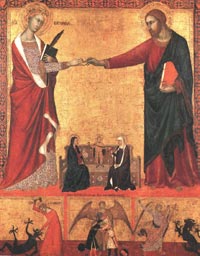
Matrimonio mistico di santa Caterina d'Alessandria, 1340, Museum of Fine Arts, Boston
|
Ugolino Lorenzetti, Nome convenzionale assegnato da B. Berenson a un anonimo pittore senese del sec. 14º, influenzato da Ugolino da Siena e da P. Lorenzetti. A U. L. sono stati attribuiti, tra l'altro, un polittico nel museo di S. Croce a Firenze, una Madonna nella pinacoteca di Lucca, dipinti nella pinacoteca di Siena e la Madonna proveniente da S. Pietro a Ovile sempre a Siena (ora nel Museo del seminario).
|
|
|
|
|
|
Bartolomeo Bulgarini
|
|
|
Il senese Bartolomeo Bulgarini, scolaro del suo concittadino Pietro Lorenzetti, è l’autore dello splendido Trittico, attualmente affisso sulla parete sinistra del presbiterio della Chiesa di S. Maria Maggiore (S.Francesco per i tiburtini) a Tivoli. Ricordato dal Vasari come allievo di P. Lorenzetti. Nel 1353 lavorava per la Biccherna; nel 1369 era a Roma, dove dipingeva in Vaticano. Non si hanno sue opere certe, si è proposto d'identificarlo anche con il cosiddetto Ugolino Lorenzetti.
|
|
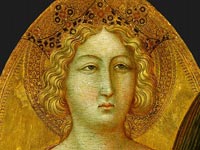
Bartolomeo Bulgarini, Santa Caterina, dettaglio, Washington, National Gallery of Art |
|
|
|
Bartolo di Fredi
|
|
|
Bartolo di Fredi (c. 1330 – January 26, 1410).
Imitando lo stile di Simone Martini e di Pietro e Ambrogio Lorenzetti, si pone all'attenzione come uno dei rappresentanti più tipici della scuola senese, con forte caratterizzazione per uno stile che possiamo dire assai "decorativo". Fu comunque uno dei pittori più importanti della seconda metà del Trecento, sia a Siena, che nelle città limitrofe che ancora oggi conservano numerose sue opere.
Anche suo figlio Andrea (1358/64 - 1428) e suo nipote Giorgio di Andrea (doc. 1409 - 1414/17) intrapresero l'attività di pittore; un altro suo nipote, Sano di Andrea (1421/91), è documentato principalmente come battiloro.
Con il pittore Andrea Vanni aprì nel 1353 una bottega a Siena: questo è l'anno in cui il nostro pittore viene citato per la prima volta .
Nonostante l'attività di pittore, fu impegnato anche a ricoprire in più occasioni importanti cariche pubbliche.
La sua opera firmata più antica che ci sia pervenuta è la Madonna della Misericordia che oggi si conserva nel Museo Diocesano di Pienza, assai influenzata dalle tavole con il medesimo soggetto di Simone Martini e Lippo Memmi.
Variamente datati al terzo quarto del Trecento sono due affreschi nel Convento di San Lucchese a Poggibonsi, con Sant'Andrea condotto al Martirio e San Nicola di Bari e le tre fanciulle.Nel 1367 firma le Storie del Vecchio Testamento nella Collegiata di San Gimignano, iniziati già nel 1356. Nel Museo di Arte Sacra si conserva una bella tavola denominata la Madonna della rosa.
Nel 1367 firma le Storie del Vecchio Testamento nella Collegiata di San Gimignano, iniziati già nel 1356. Nel Museo di Arte Sacra si conserva una bella tavola denominata la Madonna della rosa.
A Siena realizzò intorno al 1361 alcune opere, oggi perdute, nel Palazzo Comunale. Ottenne numerose commissioni dal Duomo e da altre importanti chiese cittadine: tra il 1374 e il 1409 Bartolo realizzò tavole e affreschi per numerose cappelle del Duomo, perdute o non identificate. Per Moran (1976) e Freuler (1994), la tavola con l' Adorazione dei Magi, oggi alla Pinacoteca Nazionale potrebbe venire proprio dalla Cattedrale della città, anche se i frammenti della sua predella, il più grande dei quali è Cristo in croce venerato da sante e santi al Lindenau Museum di Altenburg, presentano numerose figure appartenenti all'ordine domenicano tanto da far pensare ad una commissione di quell'Ordine.
Di nuovo a San Gimignano nella cappella alla destra dell'altare maggiore in Sant'Agostino si trovano affreschi con scene della Vita della Vergine (1374 - 1375), copiate dalle perdute scene che erano state affrescate da Simone Martini, Ambrogio Lorenzetti e Pietro Lorenzetti (1335) sulla facciata dell'Ospedale del Santa Maria della Scala di Siena. Per la stessa chiesa dipinse un polittico di cui una tavola con la Presentazione al tempio oggi si trova al Louvre (1388): in questo caso il modello è palesemente la tavola di Ambrogio Lorenzetti che si conserva agli Uffizi.
Dal 1377 al 1380 fu impegnato nella decorazione della cappella maggiore del Duomo di Volterra. Resta anche una deliziosa tavola con Madonna con Bambino, chiamata anche Madonna delle Grazie o della Pietrina dal Santuario dalla quale proviene, nel comune di Montaione, ed oggi nei depositi del Museo Diocesano di Arte Sacra di Volterra, presso il Palazzo Vescovile.
Arte in Toscana | Bartolo di Fredi
|
|
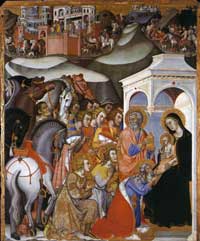 Bartolo di Fredi, Adorazione dei Magi, Siena, Pianacoteca Nazionale, 1375 - 1385 ca. Bartolo di Fredi, Adorazione dei Magi, Siena, Pianacoteca Nazionale, 1375 - 1385 ca.
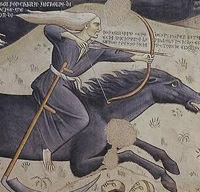
Particolare del Trionfo della Morte, attribuito a Bartolo di Fredi, Lucignano, chiesa di San Francesco
|
|
|
|
Andrea Vanni
|
|
|
Andrea Vanni, (o Andrea di Vanni) (Siena, 1332 – Siena, dopo il 1414), è stato un pittore e diplomatico italiano, appartenente alla scuola senese.
Inviato come ambasciatore a Napoli, ad Avignone, Firenze, fu anche gonfaloniere. Discepolo di santa Caterina da Siena, alternò l'attività politica per la Repubblica di Siena a quella di pittore.
Influenzato da Simone Martini, aiutò a diffondere lo stile della scuola senese nell'Italia meridionale.
La Madonna col Bambino è databile al 1390-1400 circa e conservato nella Galleria degli Uffizi a Firenze.
L'opera si trovava originariamente a Tatti, vicino Massa Marittima, nell'oratorio di Santa Maria delle Grazie, dove venne segnalata dall'Ademollo.
Affidata dalla curia grossetana alla famiglia Petruccioli, venne illegalmente venduta al Riccardi e poi al Bruschi. Le vicende del dipinto restarono per questo a lungo nascoste, tanto che Berenson lo citò come di provenienza sconosciuta, nella sua pubblicazione del 1968. Anche Boskovits si confuse, scambiando l'opera per un'altra pubblicata dal Mason Perkins che è poi stata ripubblicata dal Russoli.
Il dipinto venne acquisito dallo Stato nel 1970 per 35.000.000 di lire, e venne restaurato nel 1980. Nel 1975 la pubblicazione della Wainwright lo segnalava ancora come di provenienza ignota, mentre la De Benedictis lo comprese infine nel catalogo delle opere del Vanni, artista della scuola senese. La prima attribuzione all'autore risale comunque al De Nicola e la datazione è frutto della proposta della Padovani, che vi colse influenze di Francesco di Vannuccio e Paolo di Giovanni Fei.
La Madonna col Bambino è ritratta a mezza figura su uno sfondo dorato, che le dà una certa aurea mistica di sapore bizantino. A sinistra, sotto uno dei lobi dell'archetto, si vede un profeta con cartiglio, mentre nei due tondi in alto sono dipinti san Luca evangelista e un angelo. Maria ha un manto blu con la tipica stella sulla spalla, ricordo della Grazia divina e della stella di Betlemme, con una corona a rilievo in pastiglia e un velo lavorato interamente nell'oro. Anche la veste del Bambino, in posizione frontale, è ricavata con tantissime lumeggiature dorate.
Lo stile dell'opera ben esemplifica lo stato dell'arte senese alla fine del secolo, legata ancora all'esempio dei maestri del primo Trecento, in particolare, in questo caso, Simone Martini.
|
|
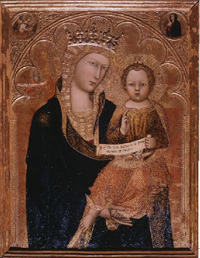
Andrea Vanni, Madonna col Bambino, 1390 circa, tempera su tavola,
Galleria degli Uffizi |
|
|
|
Francesco di Vannuccio
|
|
|
Francesco di Vannuccio (documented 1356–1389; died before 1391) was born in Siena. A small body of work has been ascribed to this painter, characterized by an attention to and love of pattern and decoration, a tradition dating back in Siena to Simone Martini. A signed and dated double-sided processional standard of 1380, painted on one side with the Crucifixion and on the other side with a painted glass depiction of the Virgin Enthroned with Saints, in the Gemäldegalerie, Berlin (inv. no. 1062B), has been the basis on which a number of other paintings have been attributed. Most of these are small-scale works, richly finished, which were meant for private devotion, suggesting that Francesco di Vannuccio worked for a discerning and wealthy group of private patrons.
The style of the Berlin Crucifixion suggests a connection with a more overtly expressive area of the Sienese tradition and with the late style of Simone Martini in particular. The beetle-browed and distinctly fleshy faces of Francesco's figures, expressive almost to the point of caricature, may ultimately derive from such models as the mourning women of Simone's Entombment (Berlin, Gemäldegal.) or the figures in the Master of the Codex of St George's panels.
|
|
|
|
|
|
Jacopo di Mino del Pellicciaio
|
|
|
Jacopo di Mino del Pellicciaio, also called Giacomo di Mino, appears to be a follower of Simone Martini. He was the contemporary of Lippo Vanni and Luca Thome, being in 1373 appointed to value one of latter's pictures. His name appears in the Sienese records from 1362 to 1389. In 1367 he aided Bartolo di Maestro Fredi at the Siena cathedral. He is known to have painted book-covers for the Biccherna, and was several times a member of the Grand Council of Siena. He frescoed for the Basilica of San Francesco.
|
|
Coronation of the Virgin of 1340-1350, typical of the smaller Gothic depictions of the subject |
|
|
|
Niccolò di Bonaccorso
|
|
|
Niccolò di Bonaccorso was active between 1372 and 1388.
Little is know about Bonaccorso, except that he may have been from Prato, and painted in the Sienese style.
|
|
|
|
|
|
Niccolo di Ser Sozzo Tegliaccio
|
|
|
Niccolo di Ser Sozzo Tegliaccio was an Italian miniaturist and illuminator of a religious codex. The painter was probably the son of an obscure Sienese illuminator, ser Sozzo di Stefano. The superb illustration of the Assumption of the Virgin in the Caleffo Bianco (a register of state documents in the Siena Archive) and the polyptych of the Virgin and Child with Four Saints (Siena, Pinacoteca Nazionale) are signed by Niccol? di ser Sozzo.
Niccolo di Ser Sozzo was born in Siena and active c. the middle of the 14th century, and died in 1363.
His most important work is The Virgin of the Assumption, an illuminated page of the Caleffo dell'Assunta. The illumination, made by Niccolò di Ser Sozzo, a skilled painter having expertise specialised in the production of manuscripts, represents the Virgin of the Assumption with St Thomas receiving the girdle, and Sts Crescenzio, Victor, Savino and Ansano.
First record of him is in Siena were he was listed to be in debt to the city in 1348 and first record of his paintings was not until the 1350s. This includes a polyptych, Virgin and Child with Four Saints, from 1362. This work is also signed by the Sienese artist, Luca di Tommè (active 1356 – 1389), assumed to be a collaborator. Though, the illuminations attributed to the artist are dated much earlier.
In the second half of the fourteenth century there are many instances of well-established Sienese master-painters collaborating on single commissions. It may be that the development was precipitated by the fact that there was not much work to go round and it had to be shared among different painters. But it seems more likely that the reverse was the case and that too much was being demanded of fewer specialist craftworkers. This large altarpiece signed on its lower edge by both Niccolo di Ser Sozzo and Luca di Tommè i n 1362 provides a striking example of such collaboration. Now divested of its original piers, pinnacle panels and predella, the altarpiece was painted probably for the high altar of San Tommaso, a church under the care of the religious order known as the Humiliati. Accordingly, the apostle Thomas is portrayed on the Virgin's right-hand side, a position conventionally understood as that of greatest honour. To his right appears Saint John the Baptist, while Saints Benedict and Stephen appear to the left of the Virgin. The general consensus among art historians is that Niccolò di Ser Sozzo painted the Virgin and Christ Child, Saint Benedict and Saint Stephen while Luca di Tommè painted Saints John the Baptist and Thomas.
In 1363, Tegliacci is noted in the Book of the Arts, (Libro delle Arti), from Siena. Of his full-sized paintings is his Madonna and Child, now in the Uffizi Gallery. In 1919, this latter piece was stolen from the church of Sant’Antonio in Bosco near Poggibonsi, and then given to the Uffizi in 1933. His other known panel painting, perhaps his earliest known, is a Madonna and Child with Two Angels, from the 1350s.
Tegliacci was known for his finely detailed, decorative style, with “fluid forms and subtle, harmonious chromatic effects…, Niccolò’s early illuminations combined Sienese refinement with Florentine concern for modeling and weight.” (Getty Center, Los Angeles) His panel works were not as elaborate in decorative detail, but showed a influence from Simone Martini.
|
|
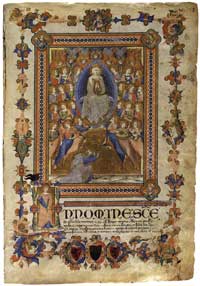
The Virgin of the Assumption, 1336-38
Illuminated manuscript, 43,6 x 30,5 cm
Archivio di Stato, Palazzo Piccolomini, Siena
|
|
|
|
Luca di Tommè
|
|
|
Luca di Tommè was active between 1356 and 1389 in Siena. He was a colleague of Bartolo di Fredi. Luca di Tommè headed a large, prolific workshop and was an influential contributor to the long legacy of Siena's celebrated artistic style, which flourished in the 1300s and 1400s. He was also active in Sienese government. Luca was probably trained by the Lorenzettis, owners of the most prominent workshop in Siena, whose work was distinguished by solid, three-dimensional forms and emotional depth. He probably learned both fresco and panel painting there, but none of his frescoes survive. Another early influence was likely the delicacy and elegant linearity of Simone Martini's work. In 1356 Luca joined Siena's newly founded painters' guild. He worked almost continuously for the Siena Cathedral. Luca's workshop created mostly altarpieces, and he often collaborated with other artists. His artistic output declined after the 1370s, possibly because his civic duties required more time. His style was marked by a growing facility at expressing emotion, relating figures to their settings by developing spatial depth, and a typically Sienese interest in drapery and ornamentation. Although Luca spent most of his working life in Siena, he also may have accepted commissions elsewhere in Tuscany.
Behold the Lamb of God, which taketh [away the sin of the world]. These words, inscribed in Latin on the scroll held by Saint John the Baptist, announce the coming of Christ. Standing against a gold background and enclosed in a Gothic trefoil frame, Saint John wears a hair shirt that represents his ascetic life of prayer and penance. Using carefully curved brushstrokes, Luca di Tommè described the woolly texture of Saint John's shirt and the unruly curliness of his hair and beard. Patterned punch marks form the decorative halo around the saint's head. The Old Testament prophets Elijah and David, who predicted the coming of the Messiah, occupy the upper corners of the frame. This panel was once part of an altarpiece, possibly for a church in Siena.
|
|
Luca di Tommè
Italian, Siena, late 1300s
Tempera on panel |
|
|
|
|
|
|
Taddeo di Bartolo (1362 or 1363 – August 26, 1422), also known as Taddeo Bartoli, was a painter of the Sienese School during the early Renaissance. He is among the artists profiled in Vasari's Le Vite delle più eccellenti pittori, scultori, ed architettori. Vasari claims he is the uncle of Domenico di Bartolo.
Taddeo di Bartolo was born in Siena. His earliest dated work is the polyptych of the Virgin and Child with Saints (1389; private collection), painted for the chapel of S Paolo at Collegarli, near San Miniato al Tedesco. The thin, elegant figures and curvilinear drapery patterns show aspects of Taddeo's early style to be linked with the works of the preceding generation of Sienese painters, and, like his contemporaries, he looked back to earlier models by Simone Martini and the Lorenzetti. Much of his early work was in Pisa, where he was responsible for the frescoes of Paradise and Hell in the Cathedral there, and for paintings in the Palazzo Pubblico and the church of San Francesco.
At the Collegiata di San Gimignano, Taddeo painted a fresco depicting the Last Judgment. A painting by Taddeo of Saint Gimignano holding the town in his lap (c. 1391) may be seen at the Museo Civico there.
A massive triptych, Assumption of the Virgin, painted in 1401, is situated in the 16th century Duomo of Santa Maria dell'Assunta at Montepulciano.
73 years after Lorenzetti completed his works, Taddeo di Bartolo painted the frescoes in the antechapel of the Palazzo Pubblico, from 1413 to 1414. These frescoes are a series of anthropomorphized images of virtues such as Justice, Prudence, Fortitude, and Magnanimity, surrounded by medallions containing portraits of ‘uomini famosi’, or famous men.
He was a conservative artist, but is noteworthy for his series of frescos on Roman Republican heroes and civic Virtues (1406-14) in the Palazzo Pubblico, Siena, which are early examples of a type that became popular in the Renaissance.
Art in Tuscany | Taddeo di Bartolo
|
|
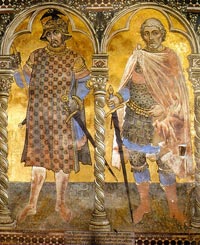 Cesar and Pompey
Cesar and Pompey, 1414, fresco
Palazzo Publico, Antechapel, Siena |
|
|
|
Andrea di Bartolo
|
|
|
Andrea di Bartolo (b. 1360/70, Siena, d. 1428, Siena) was the son of Bartolo di Fredi. He worked on many important commissions with his father (e.g. the Coronation of the Virgin polyptych, Montalcino). Later he secured a number of commissions independently of his father (e.g. St Catherine of Siena, Murano), and passed on his skills to his sons, Giovanni and Ansano. He was influenced by the great Sienese masters of the 14th century, such as Duccio and Simone Martini. He worked with Luca di Tommè.
Andrea di Bartolo ran a reliable workshop and was commissioned in 1394 to turn out a large number of more-or-less identical Virgins of Humility - one for each nun's cell of a newly built Dominican convent in Venice.
|
|
|
|
|
|
Paolo di Giovanni Fei
|
|
|
Paolo di Giovanni Fei (c. 1345 – c. 1411) came to Siena from San Quirico, Castelvecchio, held public positions in Siena from 1369 and was first mentioned in the Sienese register of painters in 1389. His earliest signed and dated work is of 1381. He appears among the documents of the Duomo di Siena, 1395-1410, and is assumed to have died shortly thereafter.
Paolo di Giovanni was influenced by the brothers Pietro Lorenzetti and Ambrogio Lorenzetti and by the Sienese masters Bartolo di Fredi and Simone Martini. His paintings are characterized by their bright clear palette often against a gilded and punched ground, and his wealth of naturalistic and ornamental detail.
Paolo, following in the tradition of Duccio and Simone Martini, used a brilliant palette—note the mosaiclike impression of his strong colors, which range from cool blues to salmony pinks and glassy greens. At the same time, Paolo has infused his scene with an appealing naturalness—legacy from another Sienese master, Pietro Lorenzetti. Paolo concentrates not on the awe-inspiring majesty of the Virgin, but on the human aspects of her story. The young Virgin pauses on the dais. Her expression as she turns a final time toward her parents is tender and rueful—the genuine response of a child.
His artistic personality was first elucidated by Bernard Berenson.
Art in Tuscany | Paolo di Giovanni Fei
|
|
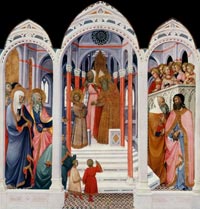
Paolo di Giovanni Fei , The Presentation of the Virgin, c. 1400, National Gallery of Art in Washington D.C. |
| |
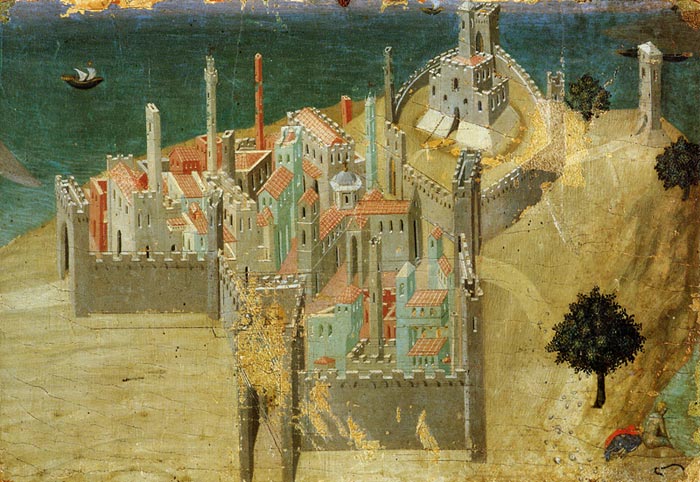 |
Sassetta (Stefano di Giovanni), (c.1340), Pinacoteca Nazionale, Siena [2] |
|
|
|
Lorenzo Monaco (Piero di Giovanni)
|
|
|
He as born Piero di Giovanni in Siena. Little is known about his youth years, apart from the fact that he apprenticed in Florence. He was influenced by Giotto and his followers Spinello Aretino and Agnolo Gaddi.
In 1390 joined the Camaldolese monastery of Santa Maria degli Angeli. He was thenceforth generally known as Lorenzo Monaco (English: "Lawrence the Monk"). In the 1390s he executed three panels of the Biblioteca Laurenziana for his convent.
Starting from around 1404 his works show the influence of the International Gothic, of Lorenzo Ghiberti's earliest works and of Gherardo Starnina. From this period is the Pietà in the Gallerie dell'Accademia in Florence. His works, often over a gilted background, showed in general a spiritual value, and usually did not feature profane elements.
In 1414 he painted the Coronation of the Virgin (now at the Uffizi), characterized by a great number of saints and brilliant colors. In the late part of his life, Lorenzo did not accept the early Renaissance innovations introduced by artists such as Masaccio and Brunelleschi. This is visible in the Adoration of the Magi of 1420-1422, where the now widespread geometrical perspective is totally absent. Lorenzo's works remained popular in the 1420, as testified by the numerous commissions he received, such as the Stories of the Virgin in the Bartolini Salimbeni Chapel of Santa Trinita, one of his few frescoes.
Art in Tuscany | Lorenzo Monaco
|
|
|
|
|
|
Benedetto di Bindo (Castiglione di Valdorcia, 1380-85 - Perugia, 1417) may have been a pupil of Paolo di Giovanni Fei and was influenced by Taddeo di Bartolo in his early works. However, the strongest influence on his art was Simone Martini. He is first recorded on 20 November 1409, when he was paid by the Opera del Duomo, Siena. He had overall responsibility for the fresco decoration of the three chapels in the sacristy of Siena Cathedral (1411-1412), one the most prestigious commissions in Siena at that date. There he worked with a group of painters sometimes called the Masters of the Sacristy of Siena Cathedral. His work has a lively narrative style and uses forceful characterization in such scenes as the Apparition of St Michael on Castel S Angelo in the chapel of the Reliquary. Between November 1415 and November 1416 he painted the frescoes in the chapel of SS Catherine and Peter Martyr in S Domenico, Perugia. Other works attributed to him include the fresco of the Assumption of the Virgin (Siena, San Niccolò al Carmine (Santa Maria del Carmine)), the Virgin and Child with SS Andrea and Onofrio (Siena, Pinacoteca Nazionale).
|
|
|
|
|
|
Domenico di Bartolo
|
|
|
Domenico di Bartolo was born in Asciano. According to Vasari, he was a nephew of Taddeo di Bartolo. He was employed by Vecchietta in the masterpiece fresco The Care of the Sick in the Pellegrinaio (Pilgrim's Hall) of the Ospedale di Santa Maria della Scala in Siena [1]. It portrays wealthy donors visiting the hospital to men washing the ill, and a fatty friar hearing confession. In 1434, he also painted a fresco panel of Emperor Sigismund Enthroned for the Siena Cathedral.
Domenico di Bartolo's major surviving achievement is his participation in a series of frescoes in the Pellegrinaio, the hall for pilgrims at Siena's Hospital of Santa Maria della Scala. The Frescoes have unusual secular subjects, which deal with the charitable, civic, and medical activities of the hospital. The Gothic vaulting of the room determined the arched openings. The settings are sometimes the rooms of the hospital itself. In their naturalism and their wealth of imagery drawn from contemporary life, these frescoes provide remarkable insight into Sienese activities.
Domenico di Bartolo died in Siena around 1445.
Art in Tuscany | Domenico di Bartolo
|
|
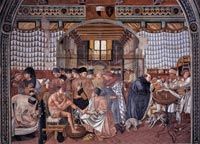 Care of the Sick (detail), 1441-42, fresco in Care of the Sick (detail), 1441-42, fresco in
Spedale di Santa Maria della Scala, Siena
|
|
|
|
|
|
|
Giovanni di Paolo di Grazia (1399 or 1407 – 1472) was an Italian painter, working primarily in Siena. His middle name was Harut after his great Armenian grandfather. He may have apprenticed with Taddeo di Bartolo, becoming a prolific painter and illustrator of manuscripts, including Dante's texts.
He was one of the most important painters of the 15th century Sienese school. His early works show the influence of earlier Sienese masters, but his later style was more individual, characterized by cold, harsh colours and elongated forms. His style also took on the influence of International Gothic artists such as Gentile da Fabriano. Many of his works have an unusual dreamlike atmosphere, such as the surrealistic Miracle of St. Nicholas of Tolentino painted about 1455 and now housed in the Philadelphia Museum of Art, while his last works, particularly Last Judgment, Heaven, and Hell from about 1465 and Assumption painted in 1475, both at Pinacoteca, Siena, are grotesque treatments of their lofty subjects. Giovanni's reputation declined after his death but was revived in the 20th century.
Art in Tuscany | Giovanni di Paolo |
|
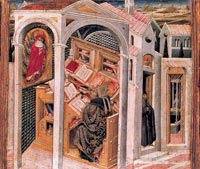 Giovanni di Paolo, St Jerome Appearing to St Augustine, c. 1456, Staatliche Museen, Berlin Giovanni di Paolo, St Jerome Appearing to St Augustine, c. 1456, Staatliche Museen, Berlin
|
|
|
|
Gregorio di Cecco
|
|
|
Gregorio di Cecco (sometimes Gregorio di Cecco da Lucca or Gregorio da Lucca di Cecco) was a painter of the Sienese School during the early Renaissance. He was born in Sienna around 1390 and died before 1424.
In 1418, he was paid for painting a cover for Sienese public records (known as a Biccherna panel). Gregorio di Cecco di Luca was greatly influenced by Taddeo di Bartolo. In 1420, he signed an altarpiece with Taddeo in the Marescotti chapel of the church of Sant’Agostino in Siena. He became Taddeo’s adoptive son and heir in 1422.
In 1421, Gregorio was part of the commission overseeing the construction of the church and loggia of San Paolo in Siena. His only surviving signed work is the ‘Madonna of Humility’ (Museo dell’Opera del Duomo, Siena) dated 1423. The polyptych of the Madonna of Humility with SS Augustine, John the Baptist, Peter and Paul (Siena, Mus. Opera Duomo), signed and dated 1423, was made for Siena Cathedral and is Gregorio's only securely attributed work. Although the figure style and decorative elements owe much to Taddeo di Bartolo, Gregorio's style is more refined, brittle and elegant and his colour more delicate and clear than his master's.
|
|
|
|
|
|
Martino di Bartolomeo
|
|
|
Martino di Bartolomeo or Martino di Bartolomeo di Biago was amanuscript illuminator active between 1389 and 1434. He was one of his generation's principal painters of the Sienese School. From specific aspects of his early style, he is believed to have trained in the studio of Taddeo di Bartolo. As a young man Martino collaborated with Giovanni di Pietro da Napoli in Pisa. The fresco cycle in the church of San Giovanni Battista di Cascina, outside Pisa, bears Martino’s signature, and the date 1398. He returned permanently to Siena in 1405. There he painted several prominent fresco cycles in the Duomo and the Palazzo Pubblico. Further official commissions for altarpieces and for polychromy of sculptures attest to his versatility and to his prestige as one of the city’s official artists.
Martino's early activity as an illuminator of manuscripts is based on Luciano Bellosi's recognition of his hand in the set of choirbooks commissioned for the cathedral of Lucca by its bishop, Niccolò Guinigi, in 1394.
When he contracted with the Collegiata of San Gimignano for the polychromy of the carved wooden Annunciation in 1420, the sculptor, Jacopo della Quercia, stood guarantor. Jacopo's father, Pietro di Angiolo, worked in Martino's shop.
|
|
|
|
|
|
The Master of the Osservanza, also known as the Osservanza Master and as the Master of Osservanza, is the name given to an Italian painter of the Sienese School active about 1430 to 1450.
The Italian scholar, Roberto Longhi, recognized that two triptychs formerly attributed to Stefano di Giovanni (il Sassetta), were the work of another hand, now generally referred to as the Master of the Osservanza Triptych. The Virgin and Child with St. Jerome and St. Ambrose (Basilica dell'Osservanza, Siena) and the Birth of the Virgin (Museo d'Arte Sacra, Asciano) are both stylisticly similar to the work of Stefano di Giovanni, but have a narrative expression that is characteristic of Late Gothic painting.
Longhi observed that another group of paintings was closely related to these works and appeared to be by the same hand. These included the predella of the Osservanza Altarpiece (Pinacoteca Nazionale, Siena), a predella of St. Bartholomew (Pinacoteca Nazionale, Siena), Scenes of the Passion (Vatican Museums, Philadelphia Museum of Art, and Fogg Art Museum), the Resurrection (Detroit Institute of Arts), and Scenes from the Life of St. Anthony Abbot (panels in the National Gallery of Art, Washington D. C., the Metropolitan Museum of Art, and Museum Wiesbaden, Germany). Additionally, the full-length painting of St. Anthony Abbot in the Louvre appears to be from another altarpiece by the same master.
Art in Tuscany | The Master of the Osservanza
|
|
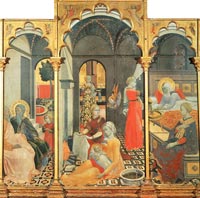
Master of the Osservanza , Birth of the Virgin with other Scenes from her Life, ca. 1428-39, Museo d'Arte Sacra, Asciano |
|
|
|
Pietro di Giovanni d'Ambrogio
|
|
|
In a period during which commissions to Sienese painters often demanded adherence to 14th-century precedents, Pietro di Giovanni produced some of the most individual and imaginative solutions, combining local tradition with elements of progressive Florentine style. A member of the Sienese painters' guild in 1428, he had probably trained with Sassetta, whose influence on him was fundamental. Only the last ten years of his brief career are documented.
The Saint Augustin panel belonged to an altarpiece, now dismembered. According to the reconstruction accepted by many scholars, the altarpiece consisted of a Virgin and Child in the centre (Brooklyn Museum, New York), St Augustin (Lindenau-Museum, Altenburg) at the left, and probably St Nicholas (lost) at the right. The three predella panels are the Departure of St Augustin (Staatliche Museen, Berlin), the Entry of Christ to Jerusalem (Pinacoteca Stuard, Parma), and the Birth of St Nicholas (Kunstmuseum, Basel).
|
|
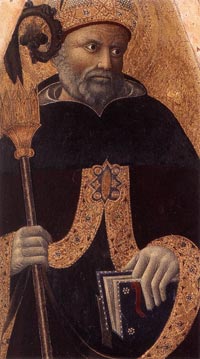
Pietro di Giovanni, St Augustin (detail), 1435-40, Lindenau-Museum, Altenburg |
|
|
|
Priamo della Quercia
|
|
|
The Ospedale di Santa Maria della Scala, one of Europe’s oldest hospitals, is situated in Siena, in front of the Duomo. The current museum complex of Santa Maria della Scala, was one of the first European hospitals expressly built to accommodate pilgrims traveling along the Via Francigena, and support the poor and abandoned children. Many great Sienese artists worked on the arrangement of the hospital, how today testifies the Pellegrinaio, with 15th and 16th century frescoes by Domenico di Bartolo, Lorenzo Vecchietta, Giovanni Raffaele Navesi and Priamo della Quercia).
The iconographic programme was conceived by rector Giovanni di Francesco Buzzichelli (1434–1444), who wanted to mark a significant change in a strongly humanistic sense, creating new compositions governed by a strict perspective, revolutionary for that time. The reference model was no longer based on religious fresco cycles on many registers, but on profane compositions that illustrated mostly cycles of chivalry or in any case, ‘civil’ histories on the walls of the representation halls of private houses or in the halls of the public buildings. This revision according to the Renaissance models was aimed at releasing the subjects of the frescoes from the religious themes and concentrate the attention on the illustration of lay myths of the foundation of the institution or on the realistic representation of the acts and works of piety that marked the daily life of the hospital. Priamo della Quercia, The Investiture of the Rector by Blessed Agostino Novello (1442).
This episode represents the investiture of the Hospital Rector by Blessed Agostino Novello who died in 1309 and who was traditionally considered to be the author of the first Statute of Santa Maria della Scala, drawn up in 1305. In reality the Hospital had already been electing its Rectors for many years, so this painting is to be considered as purely symbolic and aimed at demonstrating the importance of this famous Blessed Sienese who was linked to the Hospital and who became immediately very popular.
This fresco by Priamo della Quercia, brother of the famous sculptor Jacopo, is one of the few known works by this artist, and it is considered to be the most mediocre of the cycle of the Pellegrinaio (Pilgrims' Hall). The artist in fact tries to adapt his old style to the Renaissance innovations of Domenico di Bartolo and Lorenzo Vecchietta. The scene of the investiture takes place in front of the Cathedral – clearly seen in the background – under a Renaissance Loggia where there is not only the Rector who has been invested with an ample mantle but also another person on the left, richly dressed, who could be either the Emperor Sigismondo who stayed in Siena in 1432 or, more probably the Greek Emperor Giovanni Paleologo, who participated with his followers at the Council of Florence in 1439.
Art in Tuscany | Ospedale di Santa Maria della Scala
|
|
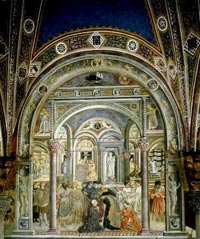
Priamo della Quercia, The Investiture of the Rector by Blessed Agostino Novello (1442). |
|
|
|
Sano di Pietro
|
|
|
Sano di Pietro (1406–1481) was an early Renaissance painter and miniaturist from Siena. He apprenticed under Sassetta and Giovanni di Paolo.
No works by Sano are known before 1443.
Sano di Pietro's paintings are housed in the National Gallery and the Cathedral Museum of Siena, the Pinacoteca Vaticana, the Brooklyn Museum of Art, the Lindenau Museum of Altenburg and the Diocesan Museum of Pienza.
The panels The Massacre of the Innocents, The Adoration of the Magi, and two others probably formed the predella of an altarpiece, probably that of the "Purification of the Virgin" formerly in the cathedral of Massa Marittima. The pictures, from about 1470, are typical of Sano's popular, conservative approach to painting, appreciated by the Franciscan order.
Art in Tuscany | Sano di Pietro
Art in Tuscany | The Adoration of the Magi
Art in Tuscany | The Massacre of the Innocents
|
|
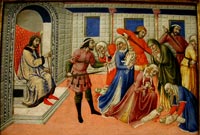
Sano di Pietro, The Massacre of the Innocents, 1470, |
|
|
|
Sassetta (Stefano di Giovanni)
|
|
|
Known as Sassetta since the 18th century, Stefano di Giovanni was the most important artist in 15th century Siena, where he probably trained with Benedetto di Bindo and where he was inscribed with the guild of painters before 1428. His first documented work was an altarpiece for the Arte della Lana (guild of wool merchants) in 1423-6, while his masterpiece was the double-sided altarpiece for San Francesco, Borgo San Sepolcro 1437-1444.
Sassetta was born in Siena, although there is also an hypothesis that he was born in Cortona. However, the first historical record of him was in Siena in 1423. Di Giovanni was probably the apprentice of Paolo di Giovanni Fei although it is also thought that he may have studied under Benedetto di Bindo. He painted in the semi-archaic Sienese School style of painting. Francesco di Giorgio e di Lorenzo, better known as Vecchietta, is said to have been his apprentice.
His precise artistic parentage is still an unsolved and most difficult problem, although it is evident that he derived some inspiration from Taddeo. In spirit and style, however, he returned rather to his earlier predecessors. Little of his work can be seen in Siena itself, but one of his most important panels is preserved in the convent of the Osservanza,
a short distance from the town.
Art in Tuscany | Sassetta
Art in Tuscany | The Adoration of the Magi
|
|

Sassetta, Adoration of the Magi; about 1435, Siena, Chigi-Saracini Collection (Monte dei Paschi) |
|
|
|
|
|
|
Francesco di Giorgio e di Lorenzo (1412 – June 6, 1480), known as Vecchietta or Lorenzo di Pietro, was an Italian Sienese School painter, sculptor, goldsmith and architect of the Renaissance. Vecchietta was born in Castiglione d'Orcia, and lived in Siena. Much of his work may be found there, particularly at the Hospital of Santa Maria della Scala, lending him yet another name: pittor dello spedale (or "painter of the hospital").
Il Vecchietta - his nickname 'little old one' has so far not been explained - was almost certainly a pupil of Sassetta. However, although enrolled in the Siena painters' guild in 1428, he does not seem to have been active in Siena until 1439 and worked instead for much of his early career as an assistant to Masolino in Rome and then at Castiglione Olona near Milan where he painted a cycle of frescoes for Cardinal Castiglione Branda. These frescoes include a view of the Santo in Padua and it is likely that Vecchietta's personal interest in highly refined and complicated architectural settings - an interest he would pass on to Francesco di Giorgio - was inspired by the archeologically oriented humanism that flourished at that time in Northern Italy, particularly in Padua. Returning to Siena, Vecchietta was entrusted with another ambitious fresco program, this time the decoration of the Pilgrim's Hospice, which he executed during the 1440s.
For the Pellegrinaio (Pilgrim Hall) at the Hospital complex, Vecchietta painted a series of frescoes, along with Domenico di Bartolo and Priamo della Quercia, including The Founding of the Spedale and The Vision of Santa Sorore, depicting a dream of the mother of the cobbler Sorore, the mythical founder of the Hospital.
Later, around 1444, he created the Cappella del Sacro Chiodo, also known as the Old Sacristy, decorated with his own work. The frescoes included Annunciation, Nativity, and Last Judgment scenes, and an Allegory of the Ladder depicting children climbing to heaven. For the high altar of the Church of the Santissima Annunziata, within the Hospital complex, he created a bronze figure of the Risen Christ (signed and dated 1476), which shows the influence of Donatello.
Vecchietta's Arliquiera, a painted wardrobe for holy relics painted by Vecchietta was placed in the Old Sacristy of Santa Maria della Scala in 1445, but is now in the National Picture Gallery of Siena.
He would go on to enjoy the support of such enlightened patrons as Aeneas Piccolomini (Pope Pius II) and Niccolo Martinozzi but increasingly turned his attentions to sculpture. Like a number of Sienese painters, notably Neroccio de' Landi and Beccafumi, Vecchietta was extremely versatile, succeeding as a sculptor as well as a painter. His extant sculptures, all bronzes, include the famous Resurrection (Frick Collection, New York) and the Risen Christ (S. Maria della Scala, Siena) which is said to have influenced Michelangelo's marble of the same subject in S. Maria Sopra Minerva, Rome.
Art in Tuscany | Vecchietta
|
|
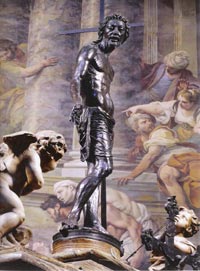 Vecchietta, Risen Christ, c. 1476, Bronze, Chiesa dell'Ospedale della Scala, Siena |
| |
|
|
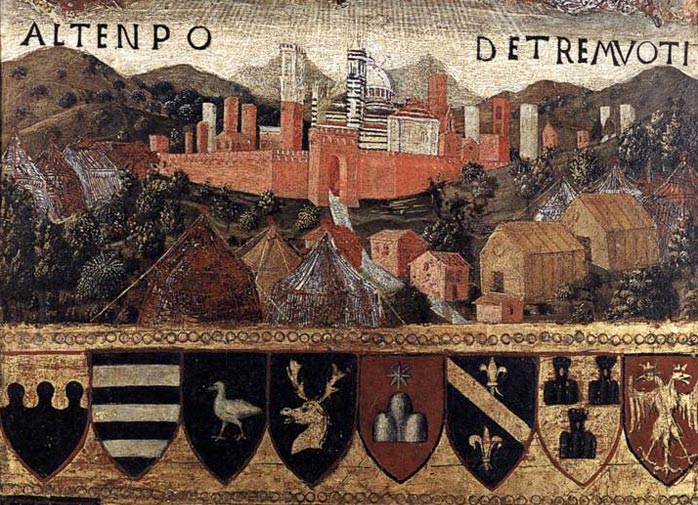 |
Francesco di Giorgio Martini, Madonna del Terremoto, detail, 1467, Archivo di Stato, Siena
|
| |
|
|
1451 - 1500
|
|
|
|
|
|
Nicola di Ulisse |
|
|
|
|
|
|
|
|
|
|
|
Matteo di Giovanni di Bartolo was born in Borgo Sansepolcro around 1430. His family relocated to Siena and he is firmly associated with the art of that ciy.
Documentation concerning the early phases of Matteo's life and career as an artist is scanty and nothing is recorded about his apprenticeship. Left to conjecture, we might imagine him as having been trained in the workshop of sculptor/painter Lorenzo di Pietro, better known as Vecchietta but he clearly was influenced by Stefano di Giovanni, called Sassetta and Domenico di Bartolo. The miniaturist Girolamo da Cremona and the Florentine painter Antonio del Pollaiolo also seemed to have contributed to Matteo's distinctive style. In 1452, Matteo entered into partnership with the painter Giovanni di Pietro, and the two shared living quarters in the San Salvatore neighborhood of Siena in 1453. That Matteo, at this time, is recorded as having colored and gilded a sculpture of the Archangel Gabriel by the celebrated Sienese sculptor Jacopo della Quercia is a reminder of the sort of tasks performed by an artist in the 15th century. Matteo and Giovanni also collaborated in the embellishment of organ shutters in the Siena Cathedral and in the decoration of the San Bernardino Chapel in that cathedral.
That Matteo had succeeded in establishing an artistic reputation is demonstrated by hia selection as one of four Sienese painters who were to furnish altarpieces for the chapels of the cathedral erected as part of the urban renewal of Pienza. For this prestigious commission Matteo painted three altarpieces. Dating to the years 1460-62, these paintings offer a secure point from which to evaluate Matteo's early style and to reconstruct his development as an artist.
The three paintings in Pienza also help to explain the next phase in his style. The first of these altarpieces, a large Madonna and Saints signed "Opus Matthei Johannis De Senis" depicts the enthroned Madonna surrounded by Sts. Catherine, Matthew, Bartholomew, and Lucy. The composition and figure types are reminiscent of those found in [Sano di Pietro]'s paintings while the draperies recall the work of Vecchietta and the St. Catherine type is derived from Domenico di Bartolo. Above this panel, in a lunette, is a flagellation scene, which, with its violent action, twisted but anatomically correct bodies, and volumetric plasticity, shows a familiarity with the progressive Florentine draftsmanship of Pollaiuolo.
Work from Matteo's middle period includes an altarpiece dated to 1477 for the Oratory of Mary of the Snowfall in Siena; the altarpiece of St. Barbara, dated to 1478-79 for Church of San Domenico, Siena; and what is considered Matteo di Giovanni's masterpiece, the Massacre of the Innocents, which is signed and dated 1482.
During his mature period, Matteo began to paint idyllic and naturalistic landscape scenes employing delicate, lyrical colors derived from the Umbrian school of painting. Matteo's brand of eclecticism tended to evolve from local taste and tradition. For this reason it is not surprising to find him producing delicate, sweet panels of the Madonna and Child, such as the panel from the Kress Collection now in the Columbia Museum of Art, depicting the Mother and child with St. Sebastian and St. Catherine of Siena, at almost the same moment that he was painting Judith with the Head of Holofernes(c.1490) now in the Indiana University Art Museum, Bloomington and the horrific events of The Massacre of the Innocents.
Matteo di Giovanni died in Siena in 1495.
Art in Tuscany | Matteo di Giovanni
|
|
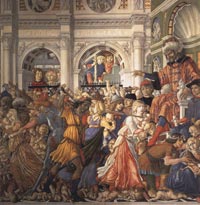
Matteo di Giovanni, Massacre of the Innocents, 1482, The Chapel of our Lady, Ospedale Santa Maria della Scala, Siena
|
|
|
|
Benvenuto di Giovanni
|
|
|
Benvenuto di Giovanni, also known as Benvenuto di Giovanni di Meo del Guasta (c. 1436 - 1509/1518) was born in Siena and lived and worked there nearly his entire life. Benvenuto di Giovanni is first documented as a young painter in 1453, when he worked alongside Vecchietta, who was probably his teacher, on the fresco decoration of the baptistry of Siena. He painted a number of altarpieces for churches in central Italy and provided the designs for the mosaic floor of Siena Cathedral.
Over the course of 43 years he produced numerous panel paintings, frescoes, and manuscripts. He was married in 1466 to Jacopa di Tommaso da Cetona and had seven children. Despite his productivity, Benvenuto did not find fortune in art. He and his wife bought a vineyard where they both worked. Later he got involved in local politics, serving two terms in public office. He continued in the early 16th century in art, frequently collaborating with his son Girolamo di Benvenuto, who also became a painter.
The Meeting of Jephthah and his Daughter
Jephthah was a great Old Testament (Judges 11:30-40) warrior, who was called upon to lead the Israelites in their war against the Ammonites. On the eve of the battle he made a pact with God, that, in return for victory, he would sacrifice 'the first creature that comes out of the door of my house to meet me when I return'. The battle won, 'who should come out to meet him with tambourines and dances but his daughter, and she only a child'.
The painting, probably part of the furnishing of a domestic interior, shows Jephthah daughter and her maidens stepping forward to welcome him on his arrival. Jephthah, on a black horse, clutches his breast in despair. The soldiers wave olive branches to symbolize the peace that will follow their victory.
The attribution to Benvenuto di Giovanni is debated, various other artists including Pietro di Domenico, Francesco di Giorgio and Girolamo di Benvenuto were also suggested.
Art in Tuscany | Benvenuto di Giovanni
|
|

Benvenuto di Giovanni, The Meeting of Jephthah and his Daughter
c. 1470, Private collection

Benvenuto di Giovanni, Lamentation, about 1490, |
|
|
Carlo di Giovanni |
|
|
|
|
|
|
|
|
Francesco di Giorgio Martini
|
|
|
Francesco di Giorgio Martini (1439-1501), who emerges as the key to much of later Quattrocento art, was an Italian painter of the Sienese School and a sculptor, as well as being, in Nikolaus Pevsner's terms, "one of the most interesting later Quattrocento architects'" and a visionary architectural theorist.
As a military engineer he executed architectural designs and sculptural projects and built almost seventy fortifications for the Federico da Montefeltro, Count of Urbino, for whom he was working in the 1460s, building city walls as at Iesi and early examples of star-shaped fortifications.
Born in Siena, he apprenticed as a painter with Vecchietta. His earliest dated works are manuscript illuminations. Mournful eyes, a halting linear flow in drapery and hair, delicately awkward posing of necks and hands, and classically inspired architecture characterize his style.
More sophisticated than his paintings, Francesco's sculpture shows acquaintance with earlier Florentine masters such as Donatello and Lorenzo Ghiberti, along with his contemporary Antonio del Pollaiuolo.
By the 1480s Francesco was among Italy's leading architects. Working in Urbino for Federigo da Montefeltro by 1477, Francesco served as a diplomat, sculpted bronze reliefs, built 136 military fortresses, and probably completed the ducal palace.
Francesco authored the first important Western writings on military engineering, works keenly studied by Leonardo and others.
Francesco di Giorgio finished his career as architect in charge of the works at the Duomo di Siena, where his bronze angels are on the high altar and some marble floor mosaics are attributed to his designs.
The typical tablet from the Biccherna (revenue office) has a votive subject: the Virgin as intercessor to protect the city against earthquake. The contribution of an anonymous assistant referred to as "Fiduciario de Francesco" is assumed.
Art in Tuscany | Francesco di Giorgio Martini
|
|
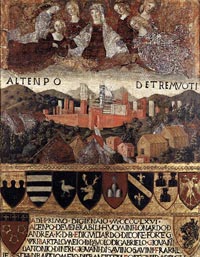
Francesco di Giorgio Martini, Madonna del Terremoto, 1467, Archivo di Stato, Siena
|
| |
|
|
|
|
Neroccio di Bartolomeo de' Landi
|
|
|
Neroccio di Bartolomeo de' Landi (1447–1500) was an Italian painter and sculptor of the early-Renaissance or Quattrocento period in Siena.
He was a student of Vecchietta, and then he shared a workshop with Francesco di Giorgio from 1468. He painted Scenes from the life of St Benedict, now in the Uffizi, probably in collaboration with di Giorgio, and a Madonna and Child between Saint Jerome and Saint Bernard, which is in the Pinacoteca of Siena.
Around the turn of the 1460s and '70s, Neroccio and Francesco di Giorgio created together a new, blonde and ethereal female ideal in Sienese painting, of which this Madonna is an especially beautiful example.
In this composition, a slender and long-necked Virgin holds before her the Child, who looks up at his mother while blessing and supporting himself on the armrest of the throne. The sweeping outline of Mary's gold-edged cloak, sharply delineated against the gold ground, still follows the Ducciesque tradition, but signs of receptivity to the new style can be discerned in every detail of the picture. The vigorous figure of the Child was inspired by the reliefs of Donatello, who spent the last years of his life in Siena.
Regarding the composition, the starting point for Neroccio's work was the Madonna type created by Sano di Pietro at the middle of the century.
In 1472 he painted an Assumption for the abbey of Monte Oliveto Maggiore, and in 1475 he created a statue of Saint Catherine of Siena for the Sienese church dedicated to her.
He separated from di Giorgio in 1475. In 1483, he designed the Hellespontine Sybil for the mosaic pavement of the Cathedral of Siena, and the tomb for the Bishop Tommaso Piccolomini del Testa.
Portrait of a Lady
Unlike other Italian cities such as Florence and Mantua, there are relatively few surviving examples of fifteenth-century portraiture in Siena - a genre that was becoming popular elsewhere. The painting of a young woman, now in the National Gallery of Art in Washington, is one that does survive. It is still in a frame that is probably original. The identity of the sitter is unknown but the treatment of the subject is typical of portraits of young women at that date. Adopting a convention derived from Flemish portraiture, it shows her head and shoulders as if from relatively close quarters. Her physical proximity is enhanced by the distant view of a lake or river in the background and the feathery trees that frame her head. The viewer is thus encouraged to examine the features of the young woman in some detail and enjoy the texture and colour of her abundant golden hair and pale skin, the embroidery of her gown and the ropes of pearls and gems round her neck.
The inscription on the lower edge of the painting where the letters OP and NER appear - is interpreted as an abbreviation of 'OPUS NEROCCIO' (the work of Neroccio). The Latin inscription is a testimony to the sitter's beauty.
Reading the two letters in the lower left corner as AP (instead of OP) some critics assume that the sitter is Alessandra Piccolomini, the grandniece of Pope Pius II, AP being her initials.
Art in Tuscany | Neroccio di Bartolomeo de' Landi
|
|
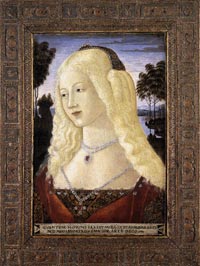
Portrait of a Lad, 1480s, Widener Collection, National Gallery of Art, Washington
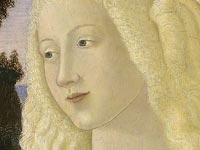
Portrait of a Lady, detail
|
|
|
|
Pietro di Francesco degli Orioli
|
|
|
Pietro di Francesco degli Orioli (approx. 1458 – 1496) was an Italian sculptor from Siena. Sienese art of the quattrocento has only recently begun to receive recognition amongst scholars, the city being celebrated primarily for its late medieval masters such as Duccio, Simone Martini, and Ambrogio and Pietro Lorenzetti.
In 1458 the Sienese cardinal Aeneas Sylvius Piccolomini was elected as Pope Pius II. The period between this date and the end of the Sienese republic in 1558 saw the development of a unique style of art from the city state, showing tendencies towards some of the more ethereal properties of the golden age of Sienese art rather than the studied realism and veneration of classical aesthetics and principles which drove many artists within the more celebrated centres of Florence, Rome and Venice. The artistic development along the line of more international gothic styles would have meant that these more famous artistic schools would probably have considered contemporary Sienese art somewhat archaeic and unfashionable.
Orioli had a relatively short artistic career (he died aged 37, and was only active independently from 1480), but his work is nonetheless important in the context of Sienese art of the period. He was a pupil of the painter Matteo di Giovannl. He is also known to have worked with the celebrated Francesco di Giorgio, a painter, sculptor and former pupil of probably the most famous Sienese sculptor of the period Il Vecchietta. It is therefore possible to deduce that Orioli was active within a circle of quintessentially Sienese artists.
His first documented work was the 1489 Christ Washing the Feet of the Apostles in the Baptistry in Siena. Other important works include "Madonna and Child with Saint Jerome and a Female Saint" c. 1490, a "Nativity" c. 1494-96 and "The Adoration of the Shepherds" dating to the last part of his career.
Stylistically, Orioli's work seems to related be to that of his Florentine contemporary, Botticelli. His painting can similarly be described as 'non-realist'. He uses pale hatching unrelated to the landscape or architecture to reinforce the contours of his figures in a way that is similar to Botticelli's Saint Zenobius panels in the National Gallery, London. Botticelli in fact uses this device later than Orioli, suggesting that either the two knew each other, or Botticelli regarded the Sienese artist very highly.[1]. Orioli's works, though very much a part of his city's artistic school, also show some more Florentine traits. His figures have a characteristically Sienese mystical quality, but also show a careful adherence to the rules of human anatomy and perspective. This can be seen most obviously in his c.1493 work "Sulpitia", a portrait of a Roman woman. This was part of a series of panels, the others being "Judith" by Matteo di Giovanni, "Artemisia" by the Master of the story of Griselda and "Claudia Quinta" by Neroccio di Landi and the Master of the Story of Griselda (all Sienese). Whilst the latter paintings show varying dgrees of success in presenting their characters realistically on painted plinths, Orioli's stands much more believably. Furthermore when seen together Orioli's figure has a dramatic, fulsome quality, with a naturalistic pose compared to the other figures which are demonstrably within the Gothic tradition of awkward, stylised poses.
Orioli was an important artist within an often overlooked school of Italian Renaissance painting. Stylistic he is similar to the contemporaries operating within his home city, as well as being related to the highly celebrated Florentine Botticelli, who he may have influenced. His work differs from that of some of his kinsmen, however, in showing what would have been seen by those outside Siena as a more modern approach. His lack of fame can most likely be attributed to the fact that he appears to have worked chiefly within Siena alone, his premature death at the age of just 37 and the general ignorance of the outside world to Sienese painting in the renaissance.
Sulpicia was chosen in the 3rd century BC from among a hundred women in Rome as the most worthy to dedicate a statue to the goddess Venus Verticordia, protector of women. Before an imaginary view of the city of Rome, Sulpicia holds a model of the temple of the goddess.
The painting is one of eight surviving related panels depicting Roman men and women who exemplified virtuous behavior. The series was probably made to celebrate the marriage in 1493 of Silvio di Bartolomeo Piccolomini (a relative of Pope Pius II) and was intended to provide moral examples for the bridal couple.
The artist's fascination with antiquity is visible not only in the subject matter but also in the classicizing linear gracefulness of the human form and the ornament of the base.
|
|
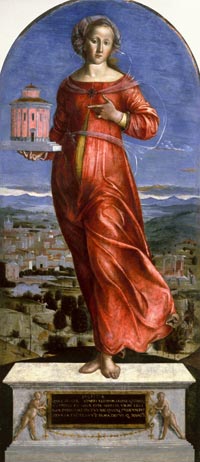 Pietro di Francesco degli Orioli, Sulpicia, ca. 1493-1495, The Walters Art Museum, Baltimore Pietro di Francesco degli Orioli, Sulpicia, ca. 1493-1495, The Walters Art Museum, Baltimore
|
|
|
|
Guidoccio Cozzarelli
|
|
|
From 1470 to 1483 Guidoccio Cozzarelli trained in the workshop of Matteo di Giovanni, with whom he was associated and with whom he is often confused. Early illuminations for the Antiphonals of Siena Cathedral and a number of securely attributed paintings demonstrate Guidoccio's development of a fine, distinctive style that reflects Tuscan and northern European as well as Sienese influences.
A scene from an Antiphonal depicting a Religious Ceremony (Siena, Bib. Piccolomini), a fragment of an altarpiece depicting the Annunciation and the Journey to Bethlehem (Coral Gables, FL, U. Miami, Lowe A. Mus.) and a cassone panel depicting the Legend of Cloelia (New York, Met.) all combine masses of rusticated and Classical architectural structures into perspective vistas. The dense cityscapes are played off against open sky and landscape, while porticos, gateways and vaulted spaces form the stage on which tactile and sprightly figures re-enact religious drama or ancient legends. In the Baptism of Christ with SS Jerome and Augustine (1470; Sinalunga, S Bernardino) the deep, panoramic landscape and triad of angels suggest Umbrian influences. A connection with Piero della Francesca through Matteo di Giovanni is possible.
|
|
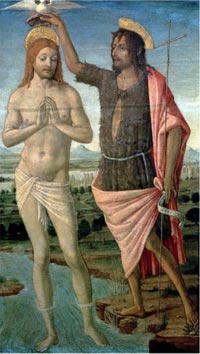
Guidoccio Cozzarelli, The Baptism of Christ, 1486
Guidoccio Cozzarelli
Madonna and Child with two Angels
tempera on panel 73x48.5 cm (end of XV century)
Buonconvento - MUSEO D'ARTE SACRA DELLA VAL D'ARBIA
Provenance: from the parish church of San Giovanni Battista in Corsano (Monteroni d'Arbia)
|
The Virgin guiding “the ship of the Republic”
The panel refers to the return to Siena of the magistracy of the Nine lead by Pandolfo Petrucci, who later became Siena’s ruler, as a welcome change occurred under the Virgin’s protection. Traditionally attributed to Guidoccio Cozzarelli it is presented at the National Gallery exhibition in London as a work of Guidoccio’s master Matteo di Giovanni.
Art in Tuscany | Sienese Biccherna Covers | Biccherne Senesi
|
|
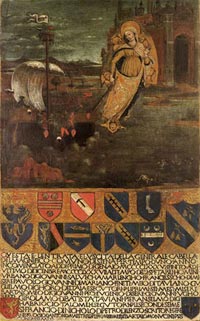
Guidoccio Cozzarelli
The Virgin guiding “the ship of the Republic”. Siena, archivio di Stato, Museo delle tavolette di Biccherna |
|
|
|
Bernardino Fungai
|
|
|
Bernardino Fungai (1460–1516) is thought to have studied under local painters in his native city of Siena, despite very little being known of his career. His paintings evince an influence from local Sienese painters and also Pietro Perugino. In 1482, he worked on frescoes for the cupola in the Siena Cathedral. Fungai was commissioned in 1494 to decorate ceremonial banners with azure and gold. He also created an altarpiece in 1512 for a Sienese church.
In a typically Sienese manner, Bernardino Fungai mingled elements of Gothic art — a tooled gold background —with the new Renaissance ideas of three-dimensionality. Fungai presented the hermit saints in three-quarter view to display his knowledge of the new concept of foreshortening, yet he retained a typically Sienese interest in decorative patterning, as seen in the Virgin's elaborate drapery. He tilted Christ's painted halo in perspective, but he incised those of the saints and the Virgin into the background. Fungai also effectively employed the characteristic linear harmonies of Sienese art in the gentle contours of the docile Virgin's mantle, the subtle scallops of her white headgear, the fluttery end of Christ's transparent drapery, and the saints' wavy beards.
The Getty Museum, Biography of Fungai
|
|
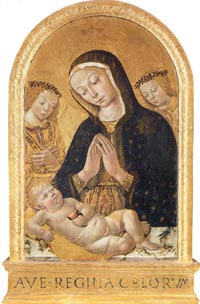 Bernardino Fungai, Madonna and Angels adoring the Infant Jesus, Pienza, Museo Diocesano Bernardino Fungai, Madonna and Angels adoring the Infant Jesus, Pienza, Museo Diocesano
|
|
|
|
Pellegrino di Mariano
|
|
|
Ten years later Pellegrino di Mariano executed the painting now in the Victoria and Albert.
|
|
|
|
|
|
Andrea di Niccolò
|
|
|
The Union of the classes and the Offering of the keys of the city to the Madonna delle Grazie, made perhaps by Andrea di Niccolò in 1483. This board is important also because testifies the original location of the Maestà made by Duccio di Buoninsegna in 1311 in the Cathedral, that is to say, in the altar. Nowadays you can see this masterpiece at the Museo dell'Opera Metropolitana.
In The Slaughter of the Innocents (lunette) and The Madonna and Child with the Saints Bernardine, Peter, Sebastian and Sigismondo in Casole d'Elsa, Andrea di Niccolò embraces the technique derived from Vecchietta through Renaissance standards (the cloister's articulate architecture in an elaborate perspective construction) and the convulsive dramatization of the slaughter influenced by Matteo di Giovanni.
Art in Tuscany | Sienese Biccherna Covers | Biccherne Senesi
|
|
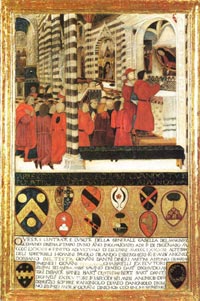 Andrea di Niccolò (?), L'unione delle classi e l'offerta delle chiavi della città alla Virgine Andrea di Niccolò (?), L'unione delle classi e l'offerta delle chiavi della città alla Virgine
The Slaughter of the Innocents (lunette); The Madonna and Child with the Saints Bernardine, Peter, Sebastian and Sigismondo
tempera on panel 290x216 cm (Signed and dated 1498)
Casole d'Elsa, Collegiate church of Santa Maria Assunta
|
|
|
|
Pietro di Domenico
|
|
|
Pietro di Domenico was a minor Sienese painter, and his works reflect the dominant pictorial styles of the era, especially showing the influence of Bernardino Fungai, Matteo di Giovanni, Francesco di Giorgio Martini and Neroccio de' Landi. The impact of Luca Signorelli and Bernardino Pinturicchio, both of whom worked in Siena for a time, is evident in Pietro's interest in landscape and the distribution in space of firmly modelled figures. A small body of attributed works has grown up around his one signed work, an Adoration of the Shepherds with SS Martin and Galganus (Siena; Pin. N.). Given the large number of motifs juxtaposed by the artist in this painting and the lack of any other documentation, such attributions should be treated with caution.
|
|
|
|
|
|
1501–1550
|
|
|
Girolamo di Benvenuto
|
|
|
Girolamo di Benvenuto was the son and student of Benvenuto di Giovanni. He produced frescoes and panel paintings, often collaborating with his father. He asserted himself as an independent painter on 1498, completing the Assumption now on display in the museum at Montalcino. His secular work is particularly important, especially his birth trays (Hercules at the Crossroad, Galleria Franchetti, Ca' d'Oro, Venice).
This portrait, one of Girolamo's finest paintings, is among the few in which his individual style can be distinguished. While in his father's workshop, Girolamo — like other assistants — would have suppressed his own style in favor of the master's.
The young woman's crisp silhouette, which creates a decorative, almost abstract play against the flat background, would have been familiar to patrons of Benvenuto. But other aspects of Girolamo's picture depart from his father's style — and from long-standing Sienese tradition. Compare, for example, its warm palette and dark colors with the brighter tones of other paintings here.
Girolamo's pursuit of his father's trade was not unusual. Artists' sons were encouraged to enter their fathers' shops, as were the sons of all craftsmen. It eliminated the need to pay apprentice wages and, in many cities, saved on guild fees, as sons were assessed lower admission. Sons might be expected to display some talent—but this was not necessarily a requirement. Long training produced skilled artisans perfectly capable of meeting clients' demands. Most Renaissance painters and sculptors were from tradesmen's families of one kind or another, if not artists, then related occupations like dyers or masons. A few came from noble families, Neroccio de' Landi for instance. Fewer still were sons of peasants.
|
|
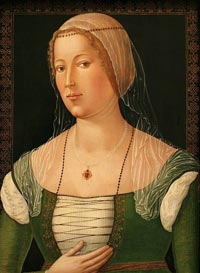
Girolamo di Benvenuto, Portrait of a Young Woman, c. 1508
Samuel H. Kress Collection
|
|
|
|
Giacomo Pacchiarotti
|
|
|
Giacomo Pacchiarotti, sometimes seen as Pacchiarotto (1474 – 1539 or 1540) was born in Siena, and worked there. Bernardino Fungai may have been his teacher. Pacchiarotti's style is influenced by Fungai, as well as Matteo di Giovanni, Perugino, and Signorelli.
A number of his paintings are in Siena.
He is recorded as having been a designer for pageants, and was active in the Sienese resistance against Florence.
Often characterized as an imitator of 15th-century models, he is more significant for his synthesis of High Renaissance tendencies into a distinctly Sienese pattern of eclecticism. His linear definition, sculptural figures, self-conscious displays of perspective and harmony of design exemplify the stylistic background against which Beccafumi’s Mannerism was formed. Pacchiarotti is also documented as a designer of pageants and was active in the resistance against Florence.One of his most important works is a tempera on panel representing the Madonna and Child with Saints, now in the Church of St. Margaret and Matthew in Ortignano Raggiolo, in the province of Arezzo. Other works include the Visitation with SS Michael and Francis (c. 1510, Siena, Pin. N.) and the Ascension (1530, Siena, Pin. N.), the Virgin and Child with Saints (1520, Casole d’Elsa, Pal. Com.) and the decorations executed between 1507 and 1514 for the Cappella Piccolomini, S Francesco, Siena (destr.).
|
|
|
|
|
|
Girolamo del Pacchia
|
|
|
Even though Giorgio Vasari mentioned Girolamo del Pacchia in his Lives of the Artists, scholars have only recently begun to separate Pacchia's work from that of his teacher Giacomo Pacchiarotti. Pacchia actually took Pacchiarotti's name, which has contributed to the confusion.
Pacchia was the son of a metalsmith who specialized in weapons. By 1502 he and Pacchiarotti were Pinturicchio's assistants, decorating the ceiling of a library in Siena's cathedral.
Throughout his career, Pacchia absorbed the influences of many painters. Along with many other Sienese artists, he adopted Perugino's classicizing style around 1510, when Perugino was painting frescoes in a chapel there. In 1518 Pacchia was painting frescoes for a church, under Domenico Beccafumi's supervision. Those frescoes reveal a thicker, softer impasto, with softer, more velvety effects than his earlier, more hard-edged works. Pacchia's style changed little during the remaining years of his career
In the Rape of the Sabines Girolamo del Pacchia created a complex panorama to fill this long and narrow panel, whose dimensions reflect its original function as part of a marriage chest, or cassone, containing a bride's household linens. Inspired by Domenico Beccafumi, Girolamo employed delicate color and the traditional Sienese grace of line to beautify the violent subject. The intertwined limbs and intense emotion conveyed by exaggerated gestures reflect Mannerist ideals, Girolamo added the rounded forms and drama of Raphael's Roman decorations.
Artists often painted the rape of the Sabines, an important incident in the legendary history of Rome. After founding Rome, Romulus solved the problem of a lack of women by inviting the Sabines, an ancient Italian people, to a festival. During the celebrations, the young Romans drove away the men and carried off the women.
|
|

Girolamo del Pacchia, Rape of the Sabines, Siena, about 1520 |
|
|
|
Domenico Beccafumi
|
|
|
Beccafumi, Domenico (1486-1551), who worked in Siena, is among the founders, some would argue the first, of Tuscan Mannerism alongside both Rosso and Pontormo, from Florence. His use of light and the soft contours and shapes of his figures long influenced other later painters across Italy.
Originally named Domenico di Pace, and also called Il Mecherino, he took the name Beccafumi from his patron, a wealthy Sienese who sent him to study in Siena and Rome. he was, with Parmigianino, the most interesting of the non-Florentine Mannerist painters, and the last of the great Sienese. A member of the High Renaissance generation, his years in Rome (1510-12) saw the painting of Raphael's Stanze and Michelangelo's Sistine Ceiling, both of which influenced him. In such works as the St Catherine Receiving the Stigmata (c. 1515, Pinacoteca Nazionale, Siena) he appears also to have been affected by Fra Bartolomeo, whose work was known in Siena. Soon after his return to Siena in 1513 his highly personal style displays characteristics usually associated with the Mannerism of the following decade. His use of strong effects of perspective and contapposto, his intensity of emotion, and his use of subtle, shot colour, as well as of lurid effects of light, are all stylistic features of central Italian painting of the 1530s and 1540s, which he probably knew as a result of the dispersal of Roman artists after the Sack of 1527.
Beccafumi designed 35 splendid mosaics from 1517 to 1546 for the pavement in Siena Cathedral, each mosaic depicting a different Old Testament scene. Beccafumi's best-known paintings are the ceiling frescoes of the Palazzo Publico in Siena and an altarpiece in the same building. Most of his best works, such as the Birth of the Virgin (c. 1543) are in Siena.
Art in Tuscany | Domenico Beccafumi in Palazzo Pubblico, Siena
|
|
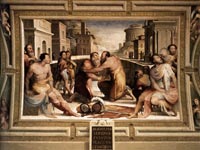 Domenico Beccafumi, The Reconciliation of Marcus Emilius Lepidus and Fulvius Flaccus (1529-35), fresco in Palazzo Pubblico, Siena Domenico Beccafumi, The Reconciliation of Marcus Emilius Lepidus and Fulvius Flaccus (1529-35), fresco in Palazzo Pubblico, Siena
|
|
|
|
|
|
|
Il Sodoma (1477 – February 14, 1549) was the name given to the Italian Mannerist painter Giovanni Antonio Bazzi[1]. Il Sodoma painted in a manner that superimposed the High Renaissance style of early 16th-century Rome onto the traditions of the provincial Sienese school.
His work bridges the High Renaissance and Mannerist styles. He was active chiefly in and around Siena, where he settled in 1501. Vasari, who disliked him, explains the origin of his nickname - 'the sodomite' - in this fashion: 'His manner of life was licentious and dishonourable, and as he always boys and beardless youths about him of whom he was inordinately fond, this earned him the nickname of Sodoma; but instead of feeling shame, he gloried in it, writing stanzas and verses on it, singing them to the accompaniment of the lute.' (Sodoma, who was married and had children) himself used the name in his signature, and Vasari's story has been questioned. Vasari also tells us that Sodoma kept a menagerie of strange animals 'so that his home resembled a veritable Noah's ark.'
He was a prolific painter of frescos and easel pictures, and he drew on a variety of sources that were not always fully digested; consequently his work often has incongruous juxtapositions and a general air of uncoordination, but it also possesses charm and a flair for decoration. His fresco of the Marriage of Alexander and Roxane (1516-17), painted for the Sienese banker Agostino Chigi, is often cited as his finest work. In his time Sodoma was considered the leading artist in Siena, but later critics have come to rank Beccafumi above him.
He spent the bulk of his professional life in Siena, with two periods in Rome.
Art in Tuscany | Il Sodoma
|
|
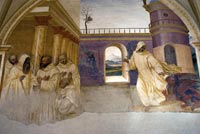 Il Sodoma, One of the seventeen frescoes in the Benedictine monastery of Monte Oliveto Maggiore Il Sodoma, One of the seventeen frescoes in the Benedictine monastery of Monte Oliveto Maggiore
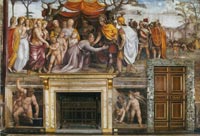
Farnese
|
|
|
|
Riccio Sanese (Bartolomeo Neroni)
|
|
|
|
|
|
|
|
|
1601–1650
|
|
|
Francesco Vanni
|
|
|
Francesco Vanni (1563–1610) was an Italian painter of the Mannerist style, active in Rome and his native city of Siena.
He was half-brother of the painter Ventura Salimbeni, and the stepson of Arcangelo Salimbeni, another Sienese painter. His stepfather died when Francesco was young, and as a 16 year old went first to Bologna, then to Rome. There he apprenticed with Giovanni de' Vecchi during 1579-80, though like other Tuscan painters of his day, he was influenced in part by Federico Barocci from Urbino, and he was among the last painters who also reflected the influence of the Sienese School of painting. He was named a Cavalieri.
In Rome, he worked later with Salimbeni, Bartolomeo Passerotti, and Andrea Lilio. He was commissioned by Pope Clement VIII to painted an altarpiece for the St. Peter's, later transferred to mosaic, Simon Magus rebuked by St. Peter. He painted several other pictures for Roman churches; including St. Michael defeats rebel angels for the sacristy of S. Gregorio; a Pietà for Santa Maria in Vallicella; and the Assumption for S. Lorenzo in Miranda.
Returning to Siena, where he ultimately died, he afterwards worked at Parma, Bologna, and again at Rome. At Siena, he painted a S. Raimondo walking on the Sea for the church of the Dominicans. Vanni painted a Baptism of Constantine (1586-7) for the church of San Agostino in Siena. He painted a Christ appearing to St. Catherine for the chapel of il Refugio at the Santuario Cateriniano of Siena, and a Baptism (1587) for the former church of San Giovannino e Gennaro. He painted an Immaculate Conception (1588) for the Montalcino Cathedral and an Annunciation (1589) for the church of Santa Maria dei Servi in Siena. One of his pupils was Rutilio Manetti.
His sons, Michelangelo and Raffaello Vanni were also painters. The painter Francesco di Vanni was active in the 14th century.
|
|
|
|
|
|
Ventura di Archangelo Salimbeni
|
|
|
Ventura di Archangelo Salimbeni (also later called Bevilacqua; 20 January 1568 - 1613) was an Italian Mannerist painter and printmaker and among the last representatives of a style influenced by the earlier Sienese School of Quattrocento-Renaissance.
Salimbeni was born in Siena. He studied painting, together with his half-brother Francesco Vanni, under their father Arcangelo Salimbeni in his native Siena,
He possibly spent some time,in Northern Italy and then moved to Rome in 1588 to work, together with others, on the fresco painting of the Vatican Library under pope Sixtus V.
During 1590-1591, he got a commission by Cardinal Bonifazio Bevilacqua Aldobrandini for paintings in the Roman Jesuit Church of the Gesù and the Basilica di Santa Maria Maggiore. These paintings show the influence of the Mannerist Cavalier D'Arpino and Andrea Lillio.
Salimbeni returned to Siena in 1595. Here he became one of the last leaders of the Mannerist school, in this period between Mannerism and Baroque. He was here influenced by Federico Barocci as can be seen in the draperies, highlighted with abrupt changes of light and flickering surfaces, of his painting "Birth of a Virgin" in the San Domenico church in Ferrara (1607-1608).
He completed painting cycles (1595-1602) for Sienese churches such as the oratory in the Santa Trinità. He is known for detailed preparatory drawings, most of which are now in the Uffizi in Florence or the Fine Arts Museum of San Francisco. He started around 1600 painting the scenes from the "Life of St. Hyacinth" for the Sienese church of Santo Spirito. These paintings show the awkward perspective of the style of the Sienese Mannerist painter Beccafumi in the backdrop of buildings and landscape. In Siena, Salimbeni completed several painting cycles for the church of Santo Spirito. He continued to create paintings for churches throughout Italy, including Florence. At the Basilica della Santissima Annunziata di Firenze, he frescoed lunettes (1605-1608) illustrating events in the history of the Servite Order. In the Duomo di San Salvatore, he executed a magnificent John the Baptist.
At about the same time, around 1600, he got an assignment in Assisi for a fresco of the "Resurrection of Christ" and the "Dying Saint Clare is visited by the pope" in the vault of chapel of San Massimo in the Basilica of Santa Maria degli Angeli.
Salimbeni got in 1603 the commission to paint frescoes with scenes from the church's patron saints in the church of Quirico and Giulitta, one of the oldest churches in Siena. As in the church of Santa Trinità, he worked here alongside with the painter Alessandro Casolari.
This was a period on non-stop new assignments : three paintings for the church San Lorenzo in San Pietro in Montalcino, the "Donation of the Keys" (1599), the "Disputa of the Eucharist" (1600) and the "Crucifixion" (1604).
At the same time he was painting the "Vision of Gregory the great" and the "Punishment of David" in the Basilica of San Pietro in Perugia. The papal legate, cardinal Bonifazio Bevilacqua (1571-1627), who had commissioned these paintings, was so pleased that he invested Ventura Salimbeni with the Order of the Golden Spur, a very selective papal order. He was even authorized from now on to name himself Cavalieri Bevilacqua. He painted the canvas of the Ascension of the Virgin (1607) for San Frediano in Pisa.
In 1612 he painted the "Life of Saint Galganus" for the Chiesa del Santuccio in Siena with the hermit saint set in a wooded landscape.
His last work of art was the oil painting the "Marriage of the Virgin" for the Seminario diocesano in Foligno in 1613.
He was influenced by Federico Barocci, Domenico Beccafumi and by the rich and harmonious palette of Lodovico Cigoli. Among his pupils was Alessandro Casolani.
In the period between 1589 and 1594 he also made in Rome some etchings, of which seven survive. They are among the finest Italian prints of the period. The earliest dated, and the largest, is the Baptism of Christ of 1589, which he produced in collaboration with the more experienced Ambrogio Brambilla.
|
|
|
|
|
|
Rutilio Manetti
|
|
|
Rutilio di Lorenzo Manetti (c. 1571 – 22 July 1639) was an Italian painter of late-Mannerism or proto-Baroque, active mainly in Siena. He was influenced and/or taught by the local artists Francesco Vanni and Ventura Salimbeni. He is known to have collaborated with Raffaele Vanni, the son of Francesco. He is known for the following works in Siena or nearby towns: Story of St Catherine and Pope Gregory (1597; Palazzo Pubblico), Baptism of Christ (1600; San Giovannino in Pantaneto); a fresco cycle of the Story of St Roch (1605–1610; San Rocco alla Lupa), Pope Alexander I freed from prison by an Angel from San Giovanni Battista in Sant'Ansano in Greti; a Temptation of Saint Anthony (1620, Sant'Agostino), a Death of Blessed Antonino Patrizi (Monticiano, 1616), a Blessed Domenico dal Pozzo at the table now in Certosa of Florence, a Birth of Virgin (1625, Church of Santa Maria dei Servi), and a painting (1628, Church of San Domenico). He painted a remarkable Allegory of the four seasons and a Parable of the blind men, now in private collections. He also contributed to the Casino Mediceo.
His style moved from one derived from Barocci to a more Caravaggesque manner after the first decade of the 17th century. Whether this change was mediated by local painters from Siena and Florence, or from direct visits to Rome, is unclear. Among his masterpieces are his contributions to the Casino Mediceo, which he worked alongsinde Matteo Rosselli, Giovanni Lanfranco, and Cesare Dandini.
|
|
|
| |
|
|
|
|
![]()
![]()
![]()
![]()

